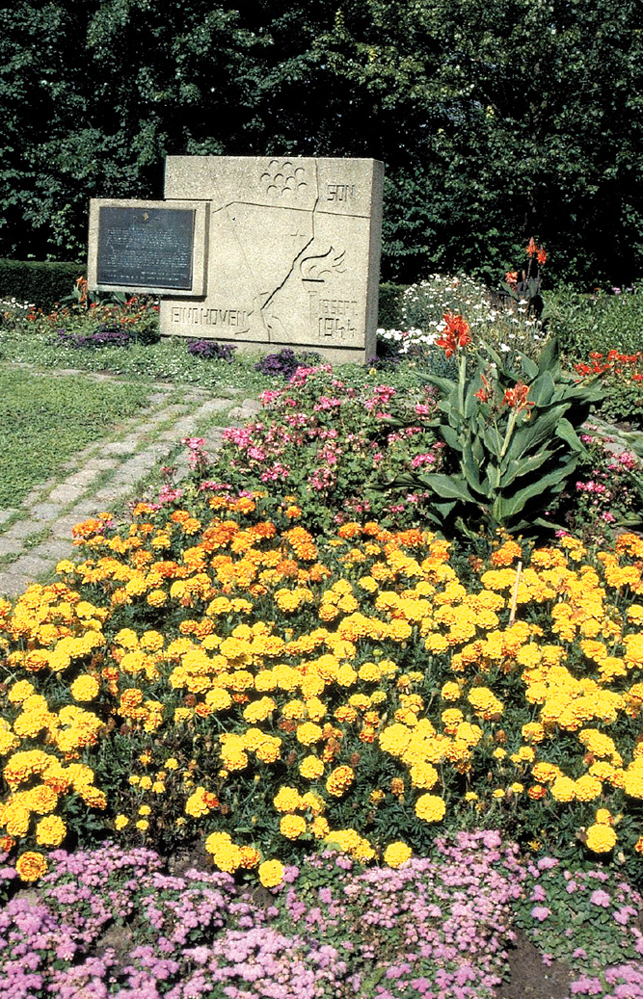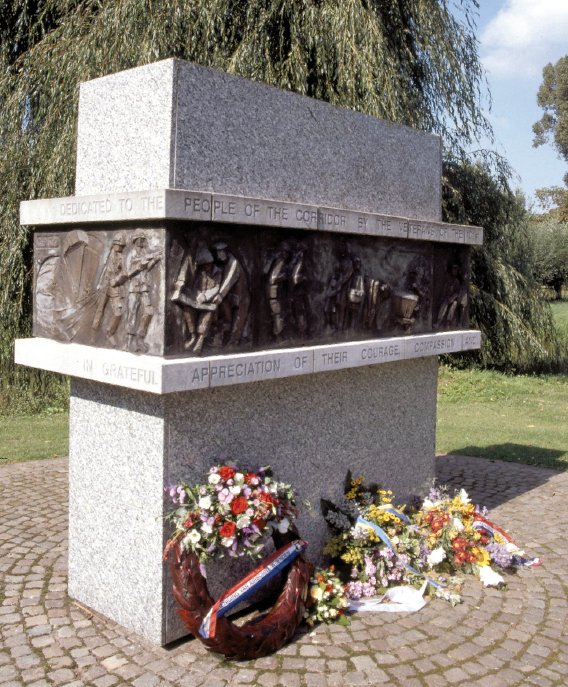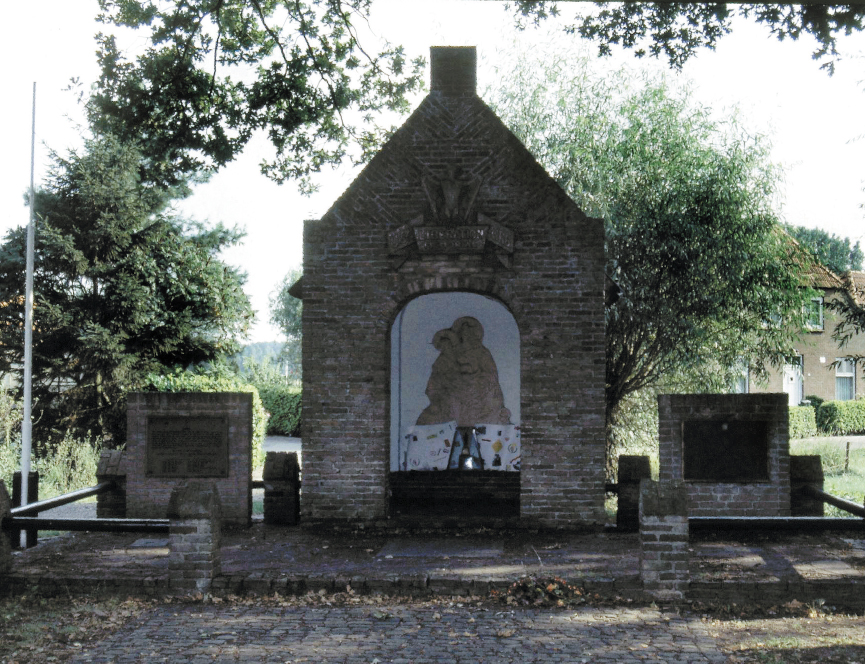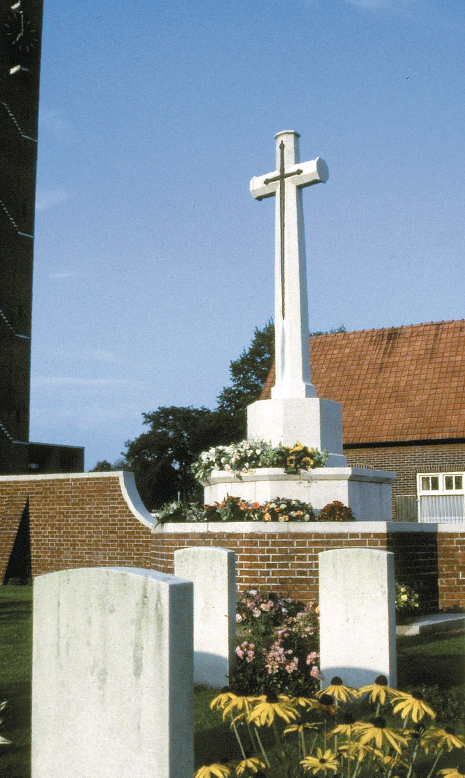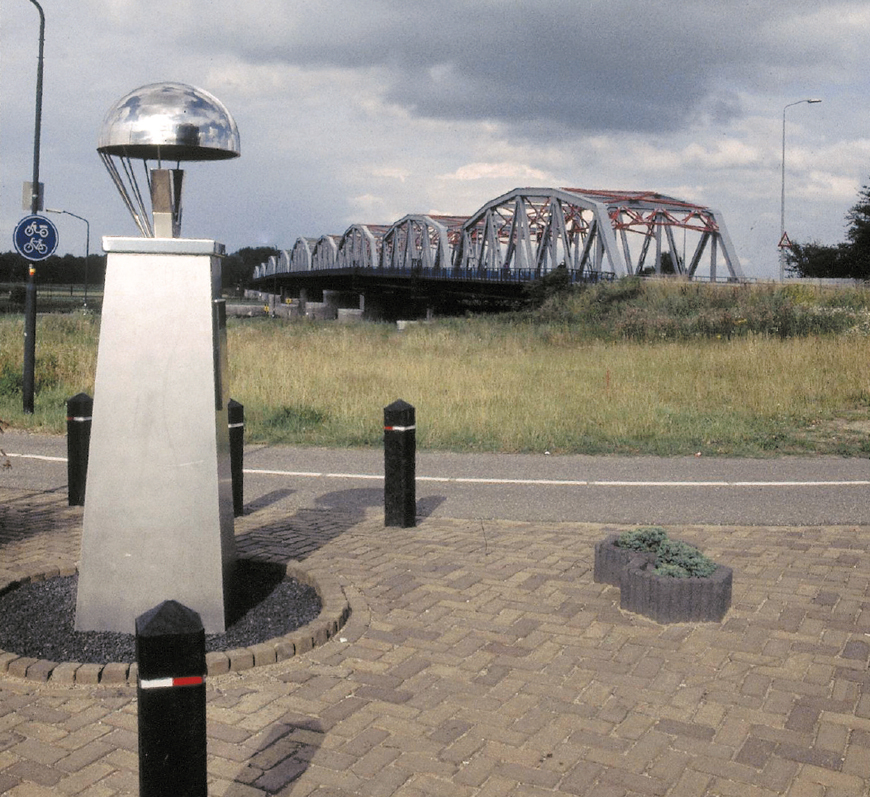EINDHOVEN TO NIJMEGEN: XXX CORPS & US AIRBORNE
• Itinerary Two starts at the VVV Eindhoven and heads north along the XXX Corps Corridor, through the 101st US AB Division DZs to Nijmegen.
• The Route: Eindhoven - Woensel CWGC Cemetery; 101st AB Div Memorial; Son - Bridgehead Memorial, New Bridge, Zonhove Screaming Eagle Memorial, Airborne Memorial, Tree to Herbert Pierce, Paulushoeve Parachute and Screaming Eagle Memorials; Best - Joe Mann Airborne Bridge Memorial, Wings of Liberation Museum, Joe Mann Open-air Theatre Memorial; Sint Oedenrode - 101st AB Memorial to Dutch, Castle Henkenshage, Memorial to Troopers Thorogood and Matthews, C47 Propeller; De Koevering Old Mill; Eerde - Local Churchyard, 501st Geronimo Memorial; Veghel - Bridge, Airborne Memorial, Dutch East Indies Memorial; Uden CWGC Cemetery; Grave - Memorials to Dutch Border Battalion, 504th PIR on old Waal Bastion, 2nd Bn (Cider-White) 504th PIR, Civilian Casualties, Burgomaster Louis Ficq, Site of Jewish Synagogue; Grave Bridge - ‘E’ Coy, 82nd US AB Div/XXX Corps/Princess Irene Royal Brigade; Overasselt Parachute Memorial; Heumen - Jac Maris Plaque, Memorial to Dutch soldiers, site of old lockbridge; Malden; Jonkerbos - Dutch Wargraves Cemetery, CWGC Cemetery; Nijmegen - VVV, Bridge.
• Extra Visits are suggested to Soeterbeek Bridge, Nuenen Liberation Memorial and 44th R Tanks and 506th PIR Benches; Best 15th Scottish Division Memorial; Schijndel - Mother Hen Monument, 51st Highland Div Memorial; St Michielsgestel - Memorial to civilians shot, Liberation Memorial; Vught - National Monument Concentration Camp, Fusillés Memorial, 51st Highland Div Room, Student’s HQ; Den Dungen Silent Wings Memorial; Heeswijk-Dinther Liberation Chapel, Landings Monument; Typhoon Room, Volkel Airbase; Airstrip B-82; Heumen - Jac Maris House; Nijmegen - Memorial to Resistance Workers, Public Garden, Herman Oolbekkinkstraat, Rustoord Cemetery, Plaque at Jewish Cemetery.
• Planned duration, without stops for refreshment or Extra Visits: 7 hours 30 minutes.
• Total distance: 115.5 kms/72.1 miles
N.B. Note that from early 2001 major road works were started to create ring roads from south of Son to north of Veghel which could well result in delays and diversions around the suggested routes below and which may require some imaginative interpretation of the directions. The resulting new roads will, however, eventually take a great deal of congestion off several important roads in this Itinerary. (See Update Page vii.)
• VVV Eindhoven/O kms/O miles/RWC
Drive under the railway line through the Vestdijk Tunnel, turn right following signs to Nijmegen/Helmond/Tilburg and turn left following the same directions just past the large yellow skittles onto John F. Kennedylaan. Exit, after the traffic lights, on Europalaan/0rpheuslaau(1.9 kms/1.2 miles) and turn left onto the bridge over the dual carriageway. Continue to the first road to the left and turn onto Baffinlaan. Continue to the cemetery on the right.
• Eindhoven (Woensel) General Cemetery/2.7 kms/1.7 miles/20 minutes/Map 1S 14b
At the entrance to the cemetery is an old brown CWGC sign and a Dutch Wargraves sign. The CWGC plots are approached by the main avenue of the cemetery, three plots (EE, KK and RR) lying to the north of it and two (JJB and JJ) to the south, near the Old Tower, the remains of a 15th Century Church that stood here until 1800. The Cross of Sacrifice and the Register Box are in Plot RR in a pleasing alignment on a large lawn.
There is a total of 687 burials in the five plots, 138 of which are UK Army, 4 Dutch Army, 1 Polish and one non-war grave. There are 426 named RAF and 6 Unknown, 49 named RCAF and I Unknown, 38 RAAF, 9 NZAF, 1 South African, 12 named Polish Airmen and 1 Unknown. Some of the aircrews are buried in joint graves.
MiD were Flight Sergeant Reginald Bazley, RAF, age 37,1 January 1945 [KK.251]; Flight Sergeant (Pilot) Norman Bowering, RAF, age 26,4 July 1941 [JJ.28]; Sergeant Ian Craig, RAF, age 32,2 February 1943 [JJB.12]; Flight Sergeant (Pilot) Herbert Hannay, RAF, age 21,12 June 1941 [JJ.12]; Sergeant Cyril Humble, RAF, age 20,12 June 1941 [JJ. 13-14]; Sergeant William Lapsley, RAF, age 20, 4 July 1941 [JJ.26]; Flight Lieutenant Peter Raw, RAF, 21 March 1944 [KK.14] and Pilot Officer Derick Shearburn, RAF, age 22, 22 September 1944 [KK.207].
Awarded the DFM were Flight Sergeant Reginald Bailey, RAF, age 22, 22 June 1944 [KK.77]; Pilot Officer William Coates, RAF, age 20, 25 March 1944 [KK.28-31]; W.Op Alexander Finlayson, RAAF, age 29, 31 August 1943 [EE.108]; Flight Sergeant Harold Houldsworth, RAF, age 20, 22 June 1944 [KK.92]; WO David Kelly, RAF, 22 June 1944 [KK.81]; Sergeant Ronald Lilleywhite, RAF, age 20, 22 February 1943 [JJB. 6] and Flight Sergeant Charles Taylor, RAF, age 20, 22 June 1944 [KK.78.].
Awarded the DFC were Flight Lieutenant (Naval) Norman Cornell, RAF, died on 22 June 1944 [KK.80] and Flight Lieutenant Gerard Johnson, RAF, age 23, died on 8 February 1945, who has a Bar to his DFC [RR.26]; Flight Lieutenant Wilmot Lowes, RAF, age 24, 1 February 1945 [RR.14]; Flying Officer (Naval/Radar) Ronald Mallett, RAF, 29 June 1944 [KK.99]; Flight Lieutenant Colin Penfold, RNZAF, age 27, 23 April 1944 [KK.44]; Flight Lieutenant John Siebert, RAF, age 23, 28 March 1941 [FF.4[; Flight Lieutenant (Naval) John Stewart, RAF, age 33, 23 May 1944 [KK.57] and Flight Lieutenant John Wells, RAAF, age 21, 22 June 1944 [KK.79].
Amongst the many lads in their late teens or early 20s lies L.A.C. Reginald Billings, RAF, age 52, 2 December 1944 [KK. 236]. The father of Private Israel Averback, ACC, age 25, 28 September 1944 [KK. Grave 133], Sapper Israel Averback, RE, died of wounds on 7 June 1918 and is buried in Bienvillers Military Cemetery near Arras. Sergeant Bernard Kipling, RAF, age 23, died on 10 May 1941 [FF. 8] lost two brothers in the war: his twin, Sergeant Guy Kipling, RAF, died 23 June 1943, who is commemorated on the Runnymede Memorial, and Corporal Peter Kipling, RASC, died on 22 June 1944, who is buried in Broomfield (St Mary) Churchyard, Essex.
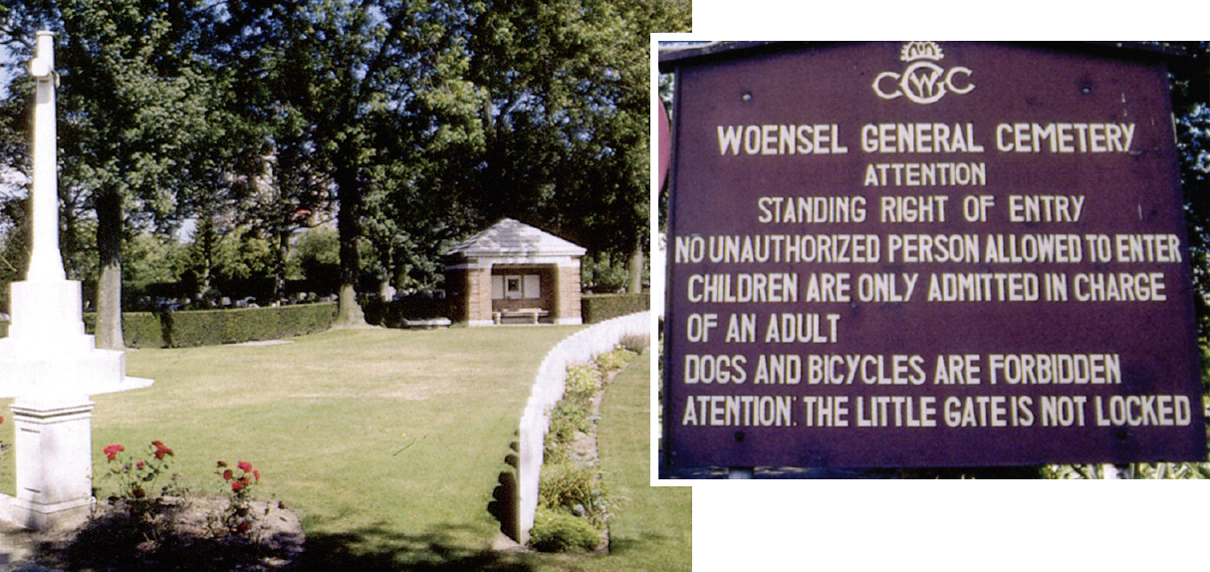
Woensel General Cemetery and Old-stylle CWGC sign
The father of Sergeant Basil Collins, RAF, age 28, died on 26 July 1942 [JJ.87], Private Harry Collins of the Ox and Bucks, was killed in Belgium on 22 August 1917 and is commemorated on the Tyne Cot Memorial to the Missing.
Lieutenant-Colonel John Symons Commanding 72 Medium Regt, RA [KK.178] age 40, 26 October 1944, was the son of Brigadier-General Adolphe Symons, CMG.
WO Donald Miller BSc, age 24,16 February 1945, served with the Dutch Sqdn [RR.33]. Sergeant Oldrich Havlik [JJ.48] and Sergeant Pauel Varjan [JJ.50], both served in the Czech Sqdn RAF, 14 April 1942. Sergeant Josef Talab served in the Czech Sqdn, 14 April 1942 [JJ.49].
Pilot Officer Noel Millidge, RAF, age 28, 27 August 1942, was a Scholar of the Guildhall School of Music and played in the BBC Empire Orchestra, the Buxton Municipal Orchestra and the National Opera Co. Orchestra [JJ.115].
Return to Europalaan and turn right, recross the bridge and then turn left back onto John F. Kennedylaan and continue northwards, passing a petrol station, to the Winston Churchilllaan/Sterrenlaan Exit.
VIokhoven Church, from whose tower General Taylor watched the advance on Eindhoven on the morning of 18 September, is over to the left, about halfway between where you rejoined John F. Kennedylaan and the Winston Churchilllaan exit.
• Extra Visit to Soeterbeek Bridge; Nuenen Liberation Monument, 44th R Tanks and 101st AB Benches, Plaque to Corporal Stothard and Trooper Nicholls. (Maps Sl-48/49/50/51 Round trip: 9.1 kms/5.7miles. Approximate time: 25 minutes
Exit, turn right along Sterrenlaan and continue to the third turning on the left, signed Nederwetten. Turn left at the traffic lights and immediately fork right on Soeterbeekseweg. Cross the bridge over the River Dommel and stop immediately on the left.
Willem Hikspoorsbrug, Soeterbeek (1.8 kms/1.1 miles). On the bridge is a sign, erected in 1984, which, translated, reads, ‘God spared us without thought at this weak bridge, whose weakness was its strength. Here the enemy had to withdraw.’ It relates to an incident on 19 September 1944 when 107th Panzer Brigade, which had been diverted from the Russian front, had arrived at Venlo railway station that morning and, via Nuenen and Nederwetten, had by evening reached the Dommel here, intending to attack The Corridor. As they reached this bridge, Willem Hikspoor, a gardener with Jonkheer Smits van Oyen, who lived near the bridge, managed to persuade Major Freiherr von Maltzan, commanding the force, that the bridge was too weak to carry their tanks. They turned round and made no further attempt to reach Eindhoven. The bridge is now named after the indomitable gardener.
Return to Sterrenlaan and turn left along Europalaan, following signs to Nuenen Centrum. Continue over the roundabout to the 2nd traffic lights, signed Centrum, to the corner of Parkstraat and Europalaan with the memorial on the left corner ahead. Turn left and immediately stop in the Congress Centre car park on the left and walk over the road.
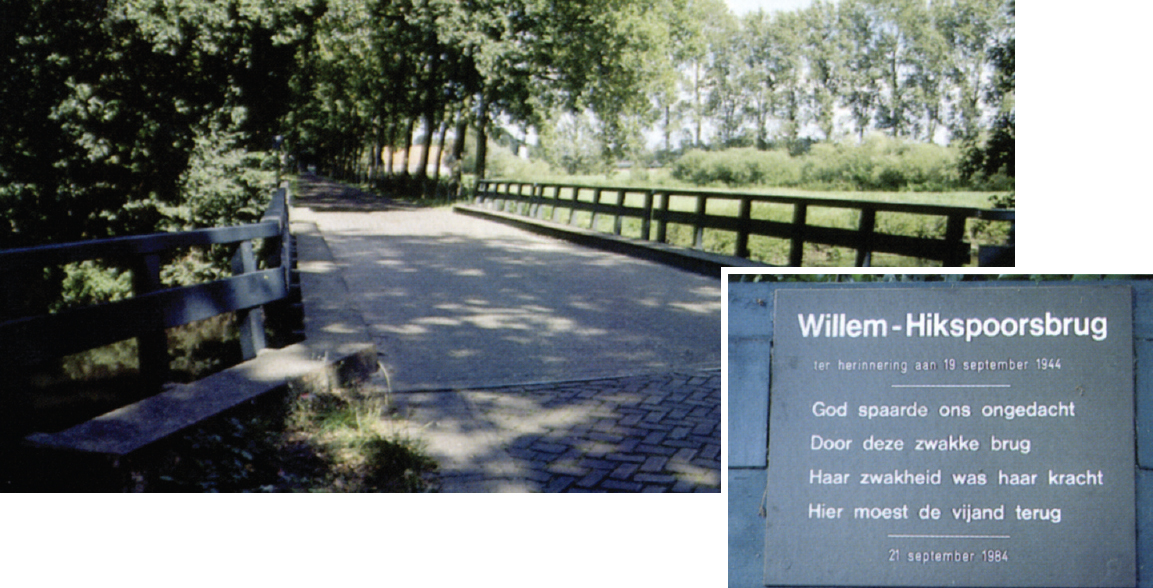
William Hikspoors Bridge over the Soeterbeek with Plaque
Liberation Monument, Nuenen. (5 kms/3.1 miles). The monument, designed by Martijn Troost and unveiled in September 1994, is in the form of an open sarcophagus, symbolising liberation. On the lid is a bas relief of the population celebrating with a flag. Behind is a wall made of bricks from the destroyed Vink family farm, which once stood here. On the wall behind the sarcophagus is a stone plaque with a picture of a tank dedicated to Corporal R. Stothard and Trooper B. Nicholls killed in action on 20.9.44 and buried in Mierlo CWGC (qv). There are also two benches beyond the memorial - one dedicated to the 44th Royal Tank Regiment, the other to the 101st AB.
Return to Sterrenlaan and pick up the main itinerary.
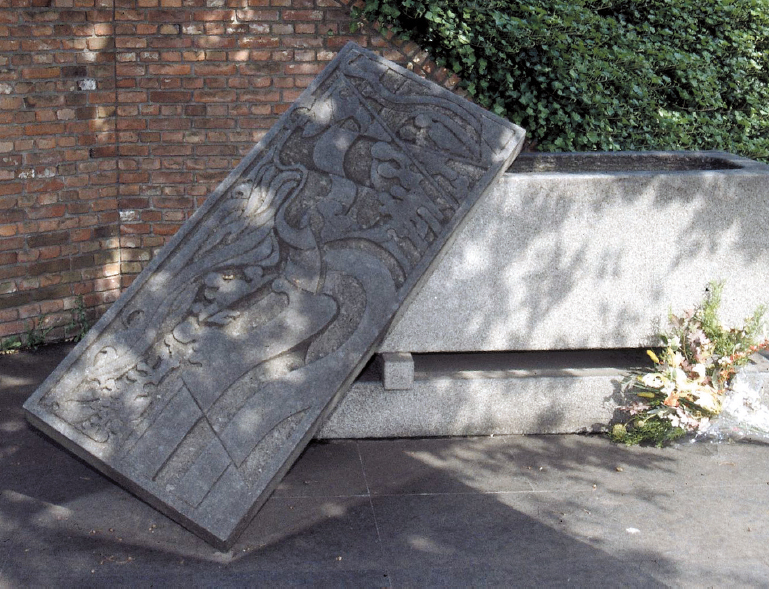
Nuenen Liberation Monument and R. Tanks Plaque
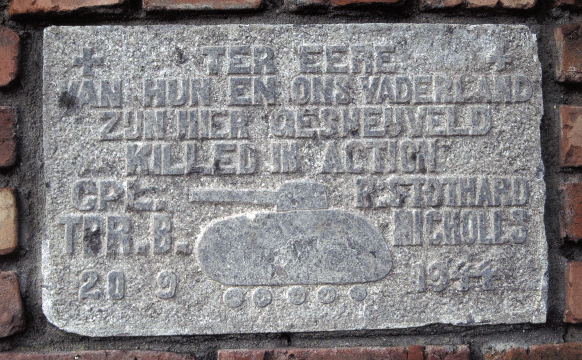
Continue along John F. Kennedylaan/N265. Take the next exit to the right signed Airbornelaan. Turn right onto Airbornelaan and 150m later turn left onto De Koppele and immediately park on the right by the school. Walk back towards the bridge. The memorial is on the right.
• 101st AB Division Memorial, Airbornelaan/5.3 kms/3.3 miles 110 minutes/Map IS/47
On the edge of the small ornamental garden surrounding the memorial is a wooden sign with a dramatic ‘Screaming Eagle’, commemorating Eindhoven’s liberation on 18 September 1944 by 101st AB Division and British 2nd Army. In the garden is a stone monument with a thematic map showing the Wilhelmina Canal, the 502nd and 506th PIR DZs, Son and Eindhoven. Alongside is a torch of freedom and the date ‘18 September 1944.’
Return to the dual carriageivay and turn right along John F. Kennedylaan, direction Son, passing another petrol station. Take the next exit towards Son and Breugel and turn right signed to Son, straight over the roundabout, past another petrol station and continue towards the Son Bridge over the Wilhelmina Canal and at the traffic lights, take the slip road on the right and stop before the bridge.
Son and Breugel. The painter Pieter Breughel the Elder (1525-1569) is presumed to have been born here; there is a memorial to him in Breugel. Further information can be obtained from the Town Hall, Raadhuisplein 4. Tel: + (0) 49 904555.
Walk across the road to the plaque in the small flower garden just before the bridge.
• New Son Bridge/Bridgehead Memorial/9 kms/5.6 miles/10 minutes/Map 1S/52
British armoured car recce units reached Son around 1700 hours on 18 September to find the bridge blown and men of the US 326th AB Engineers clearing the debris. Two and a half hours later Sappers of 14 Field Squadron arrived, pressed into service some of the German prisoners and began to build the 100ft long Class 40 Bailey Bridge that was to carry the whole of XXX Corps over the Wilhelmina Canal. It was completed at 0615 hours on 19 September and the Guards spearhead crossed immediately, led by Lieutenant Kavanagh’s troop of 2nd HCR now under command of the Grenadier Guards Group who had relieved the Irish - but they were now over 30 hours behind General Horrocks’s schedule.
This is a major river obstacle and bridging it overnight in under 12 hours was a splendid achievement by the REs. It was an indication of the urgency with which the job was tackled that when an officer asked how things were going one of the Germans asked him to go away because he was slowing up the work! The sequence in which the various units were to be positioned in the column (known as the ‘Order of March’) as it moved up The Corridor (XXX Corps transport numbered more than 20,000 vehicles) had been carefully thought out, with bridging equipment well towards the front.
Although the 101st had captured the bridge area on 17 September the Germans made a number of counter-attacks on it over the coming days that threatened to cut The Corridor. One of the first and most dangerous was launched by three Panther tanks of 107th Panzer Brigade commanded by Hauptmann Wedemeyer and supported by infantry around 1700 hours on the 19th. They approached to within 200 metres from the east along the southern bank of the canal and one shot from the leading panzer hit a British truck on the bridge and set it on fire, while another hit the bridge itself. Warned by locals of the approach of the tanks the Americans brought up a bazooka, but although they hit the leading Panther there was no apparent damage. General Taylor, who was at the bridge, raced his jeep back to the DZ and brought up a 57mm gun and its crew which, firing from the northern side of the canal, scored two hits, while a GI named Jim ‘Slick’ Hoenscheidt threw a grenade into the open turret. That finished the affair and the other tanks withdrew with their infantry, leaving six dead and one injured. Two Americans were killed, one of whom, Second Lieutenant James L. Diel, died as he ran towards the Panthers carrying TNT charges. He is buried in the American cemetery at Margraten.
On the south-western corner of the original bridgehead, on the road by the bridge, is a small marker, erected by the residents of Kanaalstraat on 17 September 1994 to commemorate 50 years of Freedom.
The present bridge was completed in 1983 on the site of the old one. It is raised to enable large boats to sail underneath.
Drive over the bridge and park in the slip road to the right. Walk over the road and turn up Debontstraat. Walk to the next turning to the right, Crocusstraat, and turn up it past the large apartment building to the right. Turn right into the car park and left at the corner of the garage block along a small brick path. On the left in a garden is
• Screaming Eagles Monument, Zonhove, Son/9 kms/5.6 miles/15 minutes/Map IS/53
In the gardens of the Zonhove, now a housing development for old people, a sanatorium in 1944, is a memorial in the shape of the Liberation Highway markers that stretch along the route from the Normandy coast. It bears a large Screaming Eagle insignia and commemorates the 2,600 wounded soldiers of the Division who were treated here in a period of four months by the nuns and friars, as well as army medics, after being transported by specially modified jeeps flown in by gliders. The memorial was inaugurated in 1962.
Walk back to your car.
N.B. Alternatively you may reach the memorial by car by continuing to the roundabout and doubling back along the slip road, passing en route, on the right, a circular concrete fountain with the legend ‘101’ around the base in the Raadhuisplein shopping area (Map 1S-54). Briefly come off the slip road as it ends and then immediately turn right on Debontstraat, drive up to Crocusstraat, turn right, park in the car park and follow instructions as for the walking directions. After visiting the memorial, follow Crocusstraat as it turns to the left and then right on Debontstraat, right on Zandstraat to September Plein. Pick up the instructions to the Airborne Memorial below from the second traffic lights.
Continue to the traffic lights in the centre and turn left signed to Best. 150m later turn right at more lights onto Europalaan.
N.B. To the left is 17 September Plein, usually a handy car parking area, but used for the weekly market on Thursday mornings. Off it, along Airborne Straat, is the Town Hall and Library where detailed town plans may be obtained.
Pass the Post Office and then the tennis club to the left and park on the left.
The memorial is in a landscaped area near a large lake with a fountain in it.
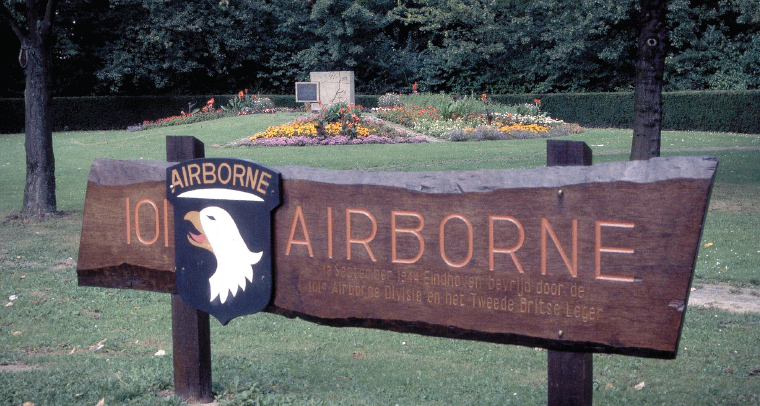
10st AB Div Memorial and sign, Airborne Laan
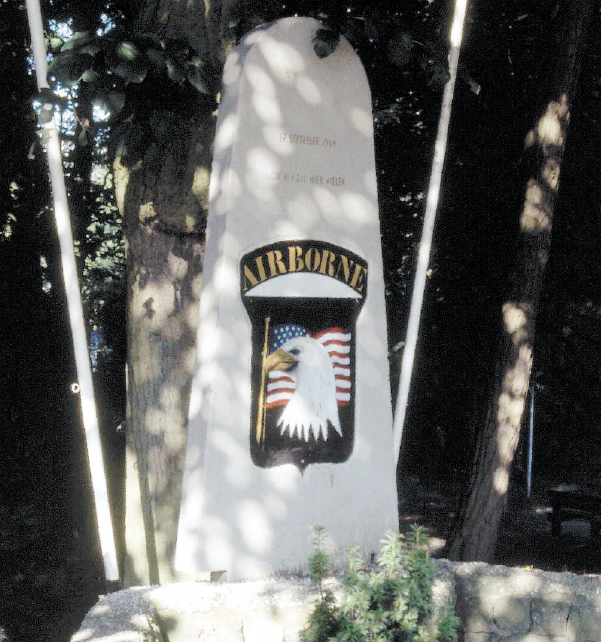
Screaming Eagles Monument, Zonhove
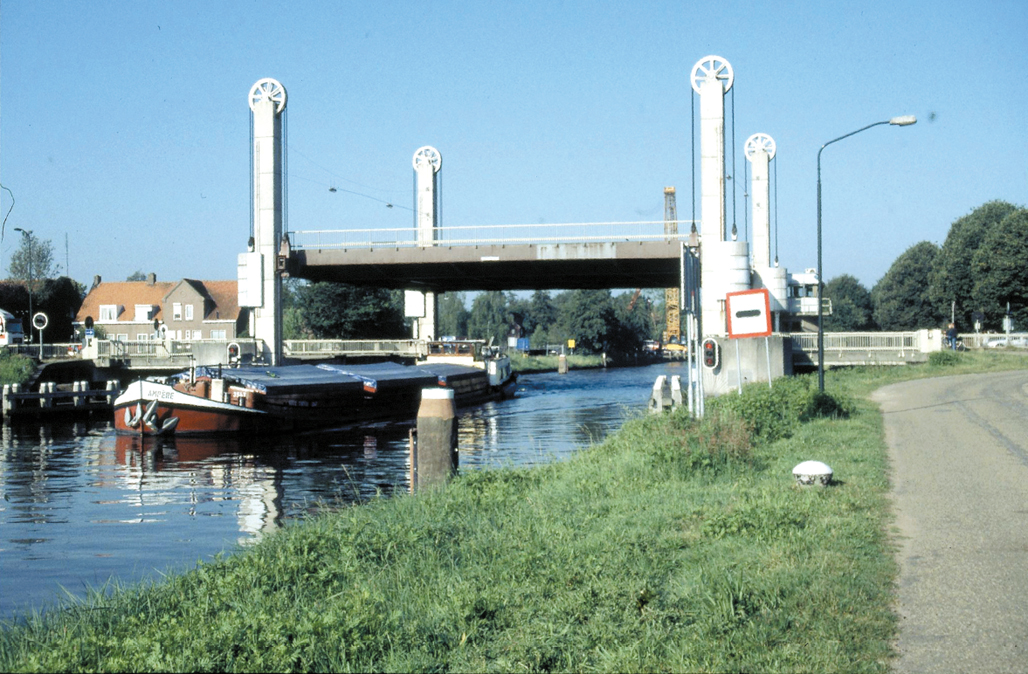
The new Son Bridge in raised position with the Bridgehead Memorial
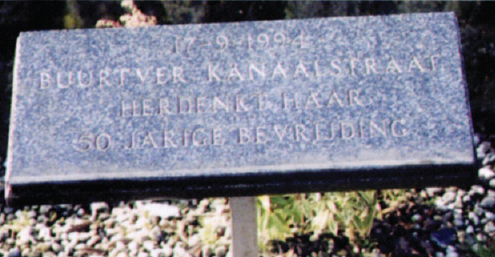
• Son Airborne Memorial/10.2 kms/6.4 miles/10 minutes/Map IS/55/OP
The memorial is in the form of a US airborne soldier who has just landed, with his parachute still attached and a grenade at the ready in his hand. A bench dedicated to 101st AB Division is beside the memorial. It was designed by Jan Lessen and Jan van Gemert and erected in 1964.
Face the airborne soldier head on.
That is 12 o’clock. The whole of 506th PIR, commanded by Colonel Bob Sink, landed in an open field in bright sunlight 2kms away at 5 o’ clock. The bridge at Son is 1km away at 12 o’clock. Two routes forward were chosen, one (2nd Battalion, commanded by Lieutenant-Colonel Robert L. Sayer) behind you to the main road down which you have driven, and continuing past the first traffic lights to the bridge. The other (1st Battalion, commanded by Major James L. LaPrade and accompanied by General Taylor) went through the woods (part of the Zonsche [Sonse] Forest that stretched west from here to Best) to your right down to the canal bank. The canal runs from 3 o’clock to 9 o’clock 1km away. At the canal the battalion was to turn left and to assault the bridge from the flank.
An 88mm gun in the woods and two more close to the canal in buildings west of the main road in the town delayed the American two-pronged attack, each arm thinking that the other had reached the bridge. As a result neither moved with utmost urgency and it was two hours before they reached the canal itself, though A Company of the 1st Battalion took one of the 88’s positions with a bayonet charge. As each force moved within 50m of their objective at about 1600 hours it was blown up, showering the Americans with debris. Immediately a small group led by Major LaPrade swam across and stormed the German positions across the canal where a fourth 88mm was positioned, roughly where the small bridgehead memorial is now. It had not fired on the Americans because the other guns had been between itself and its potential targets. Nevertheless, it was not until 0100 hours on 18 September that the whole regiment got over, having built a rope and wood footbridge. They had lost almost 30% of their strength.
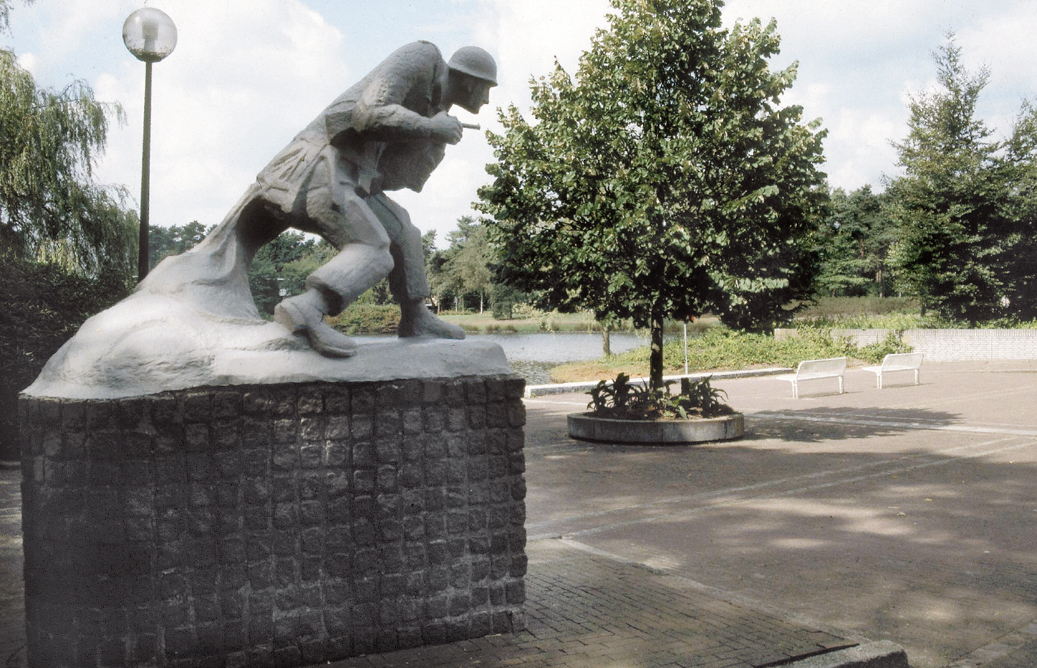
Airborne Statue, Son
The loss of the bridge and the delay in getting the whole regiment across did not stop the Americans advancing on Eindhoven at first light. ‘Occupy the center at any price. Do not waste time in fighting the Germans… the rear will take care of them,’ ordered Colonel Sink and the GIs headed south.
The Germans, however, continued to try to cut The Corridor and the following day they attacked between Son and Sint Oedenrode, stopping Corridor traffic for three hours, and assaults were also made further north on the 82nd AB Division around Groesbeek. The Sherwood Foresters were sent to help the Americans in the Reichswald area, thus becoming the first British troops to enter Germany. On 22 September the German 6th Para Regiment cut The Corridor between Uden and Veghel, delaying movement for 25 hours and two days later cut it again, although briefly, below Veghel. It has been said that even if XXX Corps had got to Arnhem in time to establish a bridgehead there it would not have improved the outcome of the operation. At the time that the Germans were making their attempts to cut The Corridor they were in the early throes of reorganisation and gaining determination daily. Every now and again they succeeded in cutting The Corridor even if only briefly. Bearing in mind that stubborn fighting went on in The Island (the area between Nijmegen and Arnhem) for over 5 months after MARKET-GARDEN was called off, a XXX Corps bridgehead at Arnhem could have been cut off by resurgent German forces just as 1st AB were, but with even greater casualities.
Continue along Europalaan to the junction with Gentiaanlaan and turn left. Continue to a junction to the right and turn up Australielaan. Turn left at the junction with Azielaan (still on Australielaan) and then immediately left onto Eifellaan through a pleasant, wiggling leafy suburban housing development. In the circle ahead is
• Herbert L. Pierce Memorial Tree/lOlst AB Seat/12.8 kms/8.00 miles/10 minutes/Map 1S/56
The plane tree was planted by 101st AB Veteran, Herbert Pierce himself on 27 April 1996. It marks the spot where he landed by parachute on 17 September 1944 on the south-east corner of the 101st DZ C. In 2000 Herbert Pierce was still in contact with friends in the neighbourhood and a regular visitor to the site. The 101st AB seat by the small garden that surrounds the tree was erected by R. J. van den Hoef who lives in No 17 Appenijnenlaan opposite. He is a member of the Son and Breugel 50 Years of Freedom Committee, who produced a marvellous book, highly illustrated with original photographs of Son and District during the Occupation and the Liberation (enquire at the Town Hall).
Return past the Airborne Memorial on Europalaan to the N260 and turn right on Boslaan. Continue over the roundabout [watch out for the effect of roadworks] and take the left turn (18.2 kms/11.4 miles) on Hogeberglaan signed to the Rendac Factory. Follow the road round as it becomes Kanaaldijk Noord, past the factory on the right, with the canal to the left, to the flyover of the A2, called Airborne Bridge. Turn right immediately before it on Boslaan Zuid. 100m further on the right is
• Joe Mann Memorial, Airborne Bridge, Best/21.8 kms/13.6 miles/10 minutes/Map 1S/57/58/59
Taking the bridge over the canal here was not one of the original tasks given to the 101st. General Maxwell Taylor, thinking that it would be wise to have an alternative route should the Son bridge be blown, sent H Company of the 502nd PIR to take it on 17 September. Unfortunately, elements of the German 15th Army were in the area and the action developed into a major and bloody confrontation involving over 1,000 German troops, American paratroopers and British armoured cars under Lieutenant Palmer (qv) of 2nd HCR. The fighting continued until dusk even though the bridge was blown at about 1100 hours on 18 September and in the fighting that day Lieutenant-Colonel Robert G. Cole, commanding the 3rd Battalion of 502nd PIR, who had won the Congressional Medal of Honour in Normandy leading a bayonet charge (see Holts’ Battlefield Guide to Normandy), was killed. (See Update Page xv.) Cole, who was also awarded the Croix dc Guerre, was never able to wear the Medal and is buried in the American Cemetery at Margraten.
On Wednesday 20 September, hearing that the Germans in the area wished to surrender, the Americans sent forward a party under a Captain carrying a white flag in order to offer terms. They were blindfolded and led to the German major in command who turned down the offer. As they were returned to their own lines their German guides said if it had been their choice they would have surrendered.
This memorial bears a photo of Joe Mann (which has twice been stolen) and the words ‘On 19 September 1944, Joe E. Mann an American soldier sacrificed his young life at this spot to save the lives of his comrades.’ The detailed story of his sacrifice (qv) is told on a plaque to the right (but see below in the entry for the second Joe Mann memorial). Designed by A. Jacobs, the memorial was unveiled by Joe’s sister, Irene Bennett-Mann, in 1984. To the left is a plaque commemorating the 5-8 July 1987 ‘Best to Berlin Memorial Run’. In the brick path leading to the memorial is the outline of a parachute.
The memorial is lovingly cared for by Dutchman Fritz Lucius of Best, an ex- WW2 Naval man who served in the Far East.
According to local experts, Joe Mann was actually killed some 200m further up the track on the left in a foxhole in what is now the high bank of the motorway. One hundred metres into the woods immediately to the right of Mann’s foxhole are the visible remnants (in the shape of well-defined depressions) of a circular defensive position where 78 Americans and 300 Germans were killed or wounded during the action in which Mann lost his life.
• Extra Visit to 15th Scottish Division Memorial, Best (MaplS/60) Round trip: 5.6 kms/3.5 miles. Approximate time: 15 minutes
Turn right under the flyover and then right again to Best, passing Macdonalds on the right and turn left signed Best at the traffic lights and then right signed Centrum. Continue to the roundabout and turn left. Continue on Hoofdstraat to the car park on the left in Boeterhoek Plein. Walk across the road to the park, Koctshuistuin, on the right. Walk across the wooden bridge to the memorial.
From 20 September 1944 the Division fought a fierce battle for Best which lasted for over a month and during which 120 young Scottish soldiers were killed. Liberation finally came on 24 October. The imaginative memorial, designed by Antoinette Briet, was inaugurated on 28 October 1994, is constructed of steel and stone in a ‘tartan’ pattern. Jumping through the centre are three bronze figures, symbolizing the bringing of freedom.
Return to Kanaldijk Noord and pick up the main itinerary.
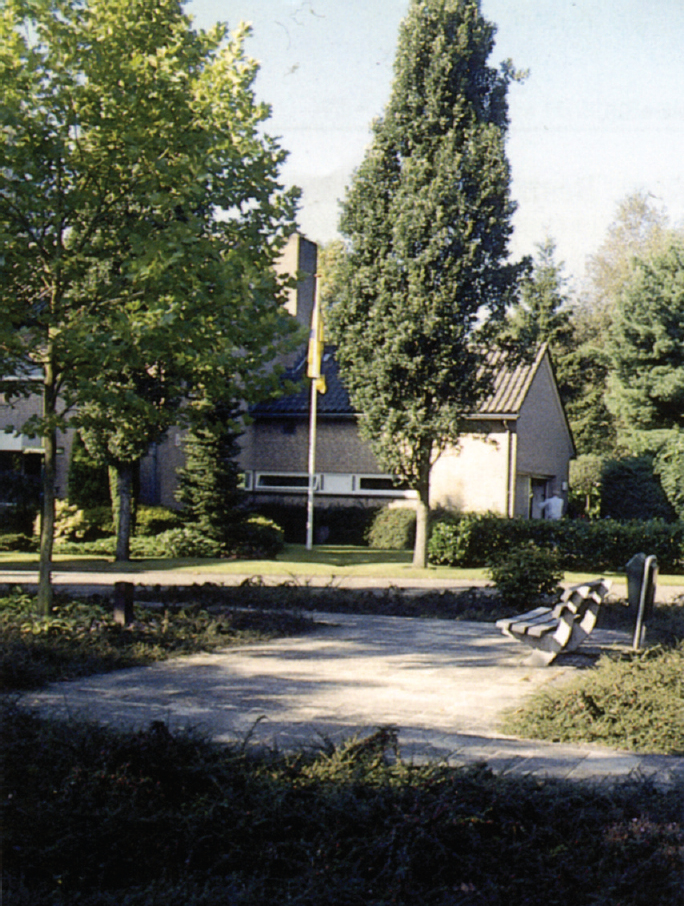
Herbert L Pierce Memorial

Tree to the left and 101st AB Seat to the right with detail
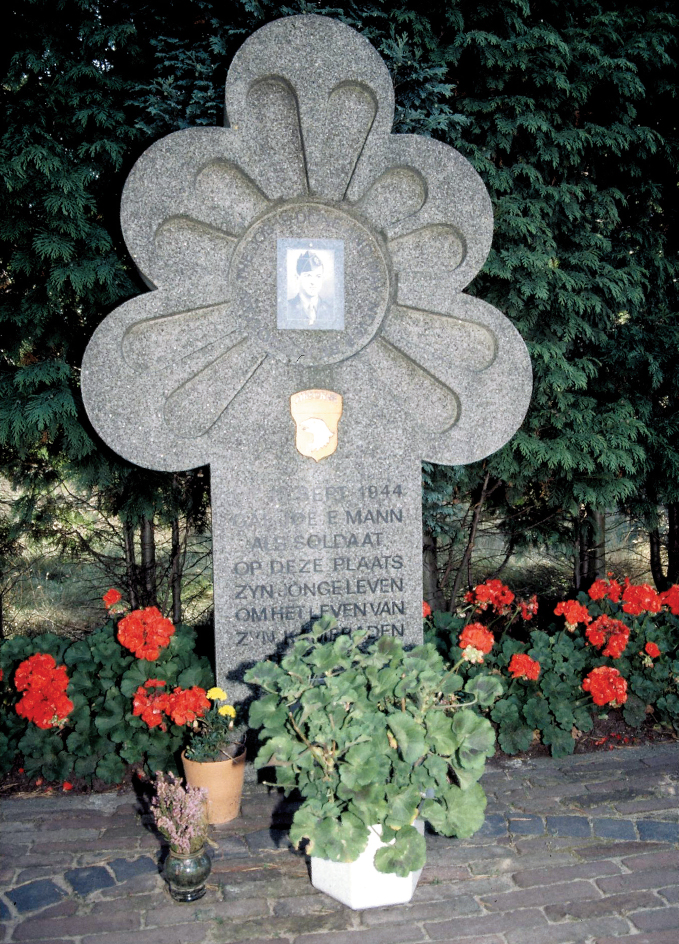
Memorial to Joe Mann MoH, near Airborne Bridge

American trenches in the Nieuwe Heide with Fritz Lucius
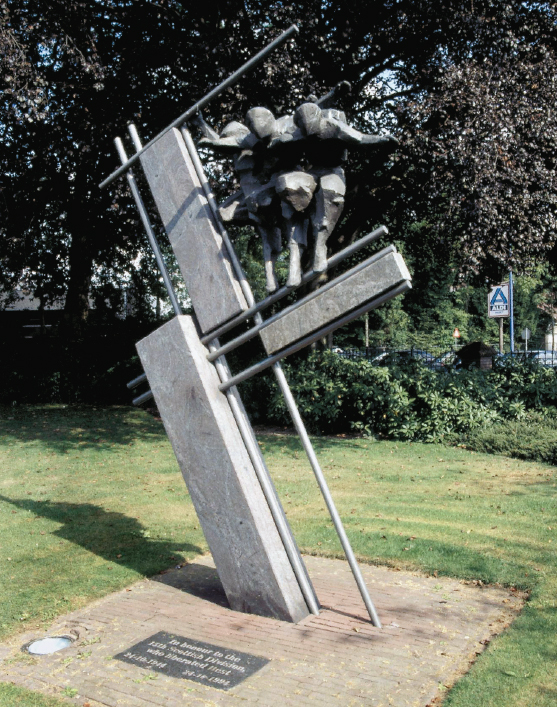
15th Scottish Div Memorial, Best
Turn round and return the way you have come to the junction with Bestseweg and turn left.
As you drive, the wooded area to your right and left is the Sonse (Zonsche to the Americans) Forest. The action here and around Best proved to be the toughest that 101st AB Division met during 18/19 September. The German forces were part of their 59th Division sent from Tilburg by General Student. The 506th PIR drop zone is 2kms away to your right
Continue to the Museum sign to the right and drive into the parking area. (See Update Page xxix.)
• Wings of Liberation Museum, Best/26.2 kms/16.4 miles/40 minutes/Map 1S/61
The museum is the brainchild of, comprises the personal collection of, and is partly financed (assisted by The Friends of the Museum Foundation) by the energetic octogenarian Mr Fritz Driessen. Born in 1921 he was arrested in 1941 by the Germans, who released him when they realised he had the contagious complaint, mumps. He then bicycled to France and worked with the Underground in France, Belgium and Holland for three years, mainly building escape lines to Spain for Allied forces. On hearing news of the impending invasion in 1944, Driessen returned to northern France and, after the breakthrough at Mortain, presented himself to the advancing US Cavalry. From then on until the end of the war Driessen worked in Intelligence with the Americans, through Belgium, Holland (where he was the first Dutchman in US uniform to cross the border of his homeland) and as far as Berlin.
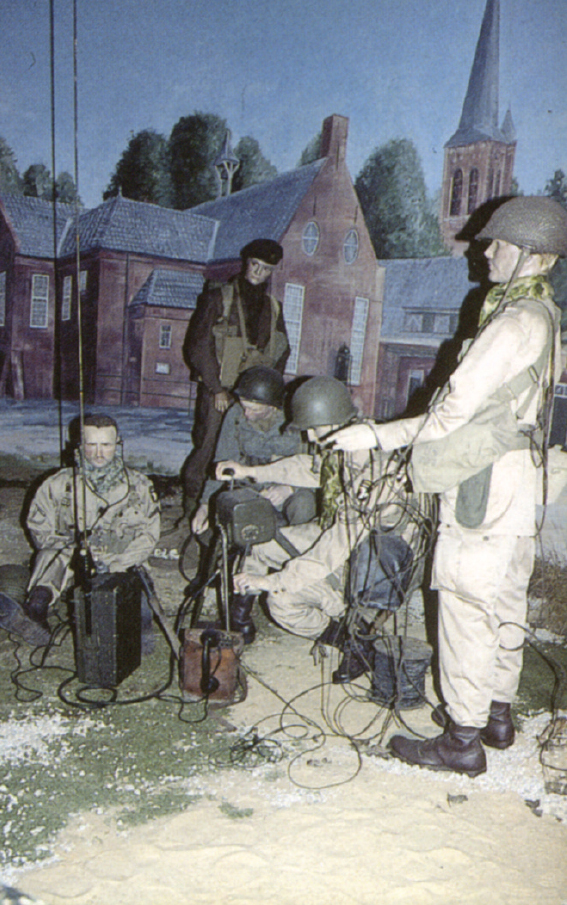
Wings of Liberation Museum, Best: Dakota ‘Darlin’ Dorien’ and Dutch Liberation Scene
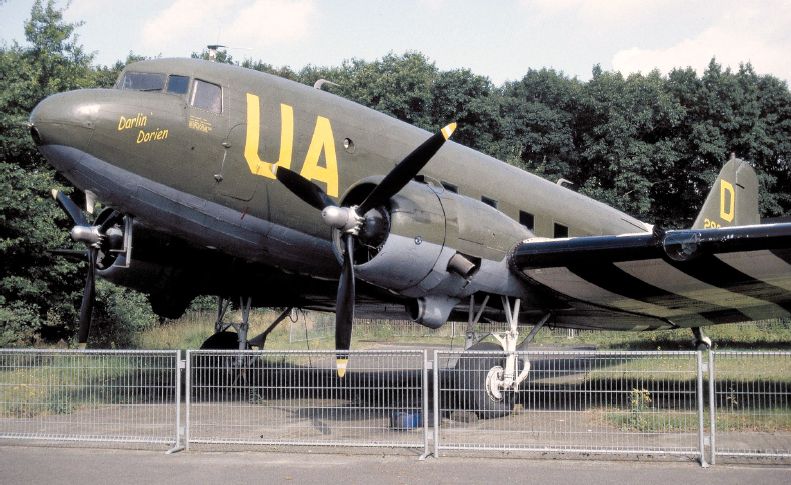
After the war Mr Driessen built up a successful business in steel, sold it and started to collect militaria. His original exhibition was in Veghel, but when the collection outgrew the space he leased this large (12 hectares) tract of land situated on one of the LZs of the 101st AB Division on 17 September 1944. The main building has a traditional chronological exhibition of the course of WW2 in Holland with documents, photographs, artefacts and memorabilia, a multi-lingual audio-visual presentation, a documentation Centre, small souvenir shop and a cafeteria.
The main glory of the museum is, however, in the large themed halls in the grounds. The first one contains a reconstruction of a typical Dutch WW2 scene immediately after the landings, incorporating original 1944 vehicles, equipment and artefacts, which is so vivid and realistic that one feels as if one has stepped back in time. Other halls are dedicated to the 51st (Highland) Division (complete with figures in colourful and authentic uniforms), to Operation BARBAROSSA (containing the T34 and a Katyusha rocket mortar personally donated to Mr Driessen by the Russians), to Aviation (including Link-trainers and flight-simulators and over 300 miniature models of WW2 planes) and a US Mobile Command Post. In the grounds, amongst the many fascinating WW2 vehicles and weapons, is an original Dakota, bought by Mr Driessen as a 75th birthday present to himself. The name ‘Darlin’ Dorien’ on the nose cone is a tribute to his daughter. The museum was opened by Prince Bernhard, a personal friend of the owner, who often pays a visit by helicopter and is then driven around in his own personalized golf caddy car. Mr Driessen has been the instigator of, and contributor to, many of the memorials in the district and his extraordinary museum, manned by enthusiastic volunteers, is well worth a visit. Allow plenty of time! Open: Mon-Sat 1000-1700. Sun: 1200-1700. Entrance fee payable with concessions for children, Senior Citizens, Veterans. Tel: + (0) 499 329722. Fax: + (0) 499 329930. E-mail: wingslib@tref.nl. Website: wingsofliberation.nl
Continue O.2kms on Bestseweg to the sign to ‘Pavilion Joe Mann’ on the left. Immediately turn left through a tall, white asymmetric concrete arch onto Joe Mann Weg. Continue through fir trees to the wooden barrier and park. The monument is to the right beyond the Joe Mann Pavilion Café.
• Joe Mann Memorial, Open-Air Theatre, Best/26.9 kmsl 16.8 miles/10 minutes/Map 1S/63/RWC (in summer)
The memorial was erected in the open-air theatre by the people of Best in memory of Private 1st Class Joe E.Mann (qv) of H Coy, 502nd PIR. It was unveiled by Joe Mann’s parents on 17 September 1956. On 18 September, the day after the bridge at Son was blown, Lieutenant-Colonel John M. Michaelis, commanding 502nd PIR, led two of his battalions through these woods in an attempt to reinforce the small force that had been sent the previous day to capture the bridge at Best that you visited earlier. At 1100 hours that too was blown and a small group of fifteen soldiers led by Lieutenant Wierzbowski (they were the core of the original force) found themselves isolated and under fierce assault. Pfc Mann and another of the fifteen attacked and put out of action an 88mm gun, but by the evening Mann had been shot four times and his arms had to be strapped to his sides to stem the bleeding from his wounds. In the dawn mist of 19 September the Germans made a grenade attack, one grenade dropping into a foxhole beside Pfc Mann and six others. Mann, shouting ‘Grenade!’, threw himself onto it, taking the full blast and saving the lives of his comrades. He was posthumously awarded the Medal of Honour, America’s highest soldier’s award. Mann’s action is reminiscent of that of Private ‘Billy’ McFadzean of the RIR who, on 1 July 1916, the first day of the Battle of the Somme, threw himself on to two grenades from which the pins had fallen out. He was blown to pieces but saved the lives of the men in his crowded trench and was awarded a posthumous VC. Wierzbowski ultimately surrendered the remnants of his force but they were later rescued by GIs of the 502nd and their captors taken prisoner.
The monument was designed by the Nijmegen artist, Ard Bernstein. He chose to represent Mann by a pelican, a symbol of self-sacrifice, derived from the legend of the pelican feeding her young with her own flesh. Four slim pillars support the mother pelican on her nest of young, and bas relief figures round the base portray Joe Mann’s heroic action.
Return to the main road and turn left towards Best.
Heavy fighting took place in the woods to the right of the road as the Americans progressed from Son to Best. The ditches on either side of the road were used as trenches and for many years after the war cartridge cases were to be found in them.
Continue to the next road to the right, Molenheideweg, and turn up it.
In the woods to the right, the traces of foxholes can still be discerned. Along the first turning to the left, Oude Baan, the Germans built a fake runway.
Continue on the road, which has now become Sonniuswijk, to the farm on the left, No 42/42a.
• Parachute/Screaming Eagle, Paulushoeve, Son/30.9 kms/19.3miles/10 minutes/Map 1S/64
N.B. Please remember that this is private property.
The owner of the farm, Wan van Overveld, has erected a metal parachute in the garden and on the house is a Screaming Eagle. The latter was to celebrate the 40th Anniversary of MARKET-GARDEN and was a gift of the Association of Dutch Airborne Friends. The farm was on DZ C (506th PIR) to the south. It was used as an identification point because the name of the farm was written on the roof. An airstrip, LZ W, was then constructed behind the farm from which gliders were taken back to the U.K. The ties between the American liberators and the van Overveld family have remained strong, and, until recently, important commemorative ceremonies were held here.
A PERSONAL MEMORY
By Liza van Overveld, age 14 in 1944.
[Liza, who still lives in a cottage adjoining the farm, remembered going to church with her mother and two-year-old sister on the morning of Sunday 17 September 1944. During the service the priest told them that the church was surrounded by Germans looking for Dutchmen to dig foxholes for them along the Son Canal. The men all left the church by the back door and were saved. On the nervous journey home, Liza saw the sky fill with aeroplanes, flying low and making a deafening sound, soon augmented by the noise of a heavy bombardment. They managed to get home and the whole family hid in the cellar until they heard loud cries of joy]

Joe Mann MoH Pelican Memorial, Open-Air Theatre near Best
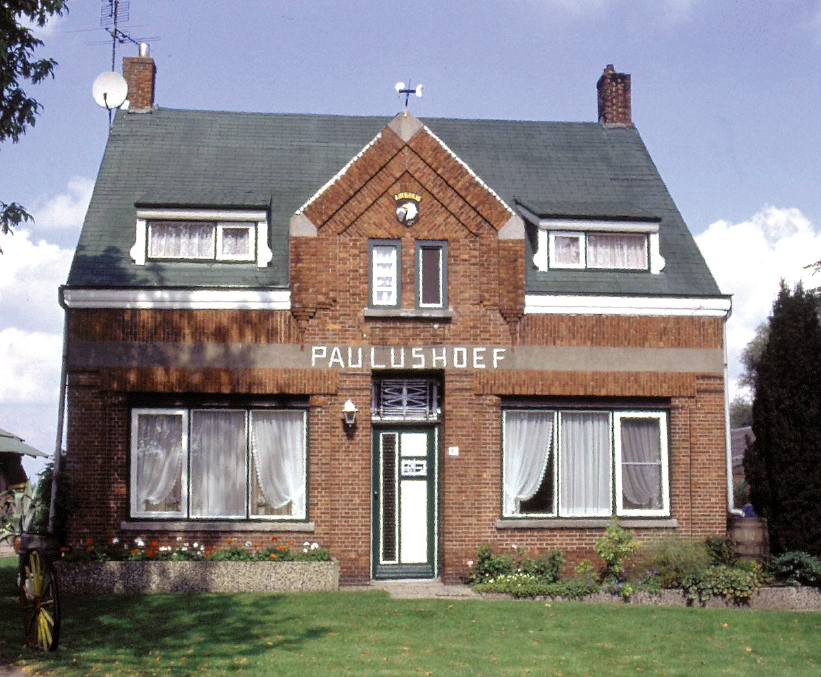
The Paulushoeve with Parachute Memorial
‘We ran out of the cellar. Unforgettable! There we were standing eye to eye with our liberators…. Sympathetic men, out of another part of the world, come all the way to us, risking their own lives! And everything that happened in the moments after that was as in a dream. We had to talk with our hands and feet. Unfortunately the language was a big problem. Especially the leaders of the paratroopers were anxious to get information from us about “where to…”. They lost their awareness of direction. Most of them had a map and compass but they were on strange territory full of enemies.’
[The family gave the paratroopers milk and whatever help they could. Some of them made their way towards Son and the bridge over the Canal, others to Best. Then came the gliders.]
‘It was beautiful to see the gliders land… . You could see them opening their front and all of a sudden a jeep drove out of it in full speed into the meadows. They were so quick those Yankees. In the meantime we were smothered with chocolate, cigarettes, chewing gum and even with their own ration packages. We were spoiled and we were more than happy… . What struck us was their extreme politeness. As well as their big love for children…. The first day the lightly wounded men were bound up and attended to in our living room by a doctor or medic. They worked very quickly and efficiently.’
[They were not the only casualties. Many of the farm’s cows were killed and their beloved horse ‘de Vos’ was blinded by the bombardment. And soon refugees from Best, who had lost everything in the fighting and had to run for their lives, made their way to the farm.]
‘But the Americans who were with us … were a very great support for us. They kept cool and by doing so gave us confidence and hope.’
Continue to the junction with the N265. (See Update Page x.)
N.B. At this point, the hamlet of Wolfswinkel is across the other side of the road. It was there that Maxwell Taylor had his HQ on 20 September. That same day General Ridgway, held up south of Son, drove around vehicles of XXX Corps and arrived here. Later in the day he returned to Eindhoven to see Brereton and then went north to Groesbeek to meet Gavin who was in the middle of a desperate struggle and had little time to talk to him. On the left-hand side of the road to the right is Waterhoef Farm, with the name in white on the roof, behind which was a temporary US cemetery (qv) containing 450 graves. (See Update Page xxviii.)
Turn left direction St Oedenrode. Exit at St Oedenrode and then turn left on Sonseweg. At the next junction turn left, back over the N265, and immediately right following signs to St Oedenrode. At the following roundabout turn right on Nijnselseweg. At the next roundabout turn right following signs to Schijndel on Corridor.
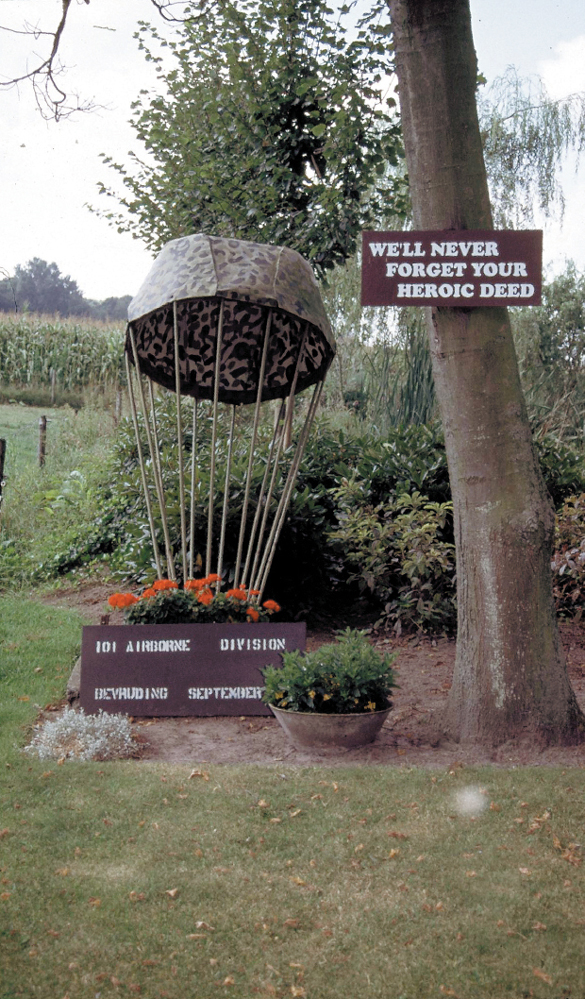
• Sint Oedenrode
The town is so-called from the combination of the name of an 8th Century Scottish Princess, Oda, who settled here, and ‘rode’, meaning a small wood. More information can be had from the VVV, St Paulusgasthuis, Kerksraat 20.
Open: Mon-Sat: 1 April-1 September. Other months, Tel: + (0) 413 474100.
St Oedenrode was occupied by the Germans until the arrival of the 101st Airborne Division on 17 September, followed two days later by units of the British Army. Together they established a corridor through the village for the passage of troops, during the fighting for which there were both civilian and military casualties. A temporary hospital was set up in the Roman Catholic Girls’ School and the twenty-three British soldiers (including 1 Unknown) who died there were buried here.
502nd and 506th PIR dropped to the west of The Corridor between Sint Oedenrode and Son. 502nd PIR dropped nearest St Oedenrode with Lieutenant-Colonel Patrick Cassidy, CO of 1st Battalion, and General Maxwell Taylor, the divisional commander, in one of the leading aircraft. 1st Battalion had the task of taking St Oedenrode. Two German tanks, which could have given opposition, were destroyed by fighter bombers and by nightfall the Americans had overcome slight but determined small arms fire from rear-echelon troops, to capture the town and take fifty-eight prisoners. Fighting continued for more than a week under constant German artillery fire, but, helped for two days by an Irish Guards tank that had been damaged and left behind by the regiment, the Americans cleared the road to Schijndel and never let St Oedenrode be recaptured. The tank commander, Sergeant Paddy McRory, was recommended by the Americans for the Silver Star. The town issued a handsome scroll of thanks to its liberators in October 1944.
The following monument is then passed on the left but proceed to the next roundabout and double back to it, over the bridge over the Dommel and past the giant yellow clog on the right, so as to be able to pull in on the parking area on the same side of the road.
• Sint Oedenrode Monument to the Dutch from 101st AB Veterans/38 kms/23.7 miles/10 minutes/Map 1S/67
The memorial was initiated and funded by the Americans in recognition of the level of resistance in the Brabant and the help that their forces received from the local population in 1944. It was the brainchild of veteran John Seney and was designed by Frans Alkemade, Andre van Bergeyk and Trudy Peters-Broos. It was unveiled on 21 September 1994 by Lieutenant-General Harry Kinnard who in 1944 commanded the 501st PIR which landed in the wrong place, almost on top of Castle Heeswijk. The inscription is ‘Dedicated to the Dutch people in grateful appreciation’ and around the monument are scenes of the landings in bronze bas relief.
Continue to the roundabout and turn right following signs to Centrum and VVV along Hertog Hendrikstraat to the T-junction in the centre.
The VVV is in the corner on the right at Kerkstraat 20.
Turn left on Kofferen signed Best. Continue to the large glass and concrete building on the right. Turn left, signed ‘Kasteel Henkenshage’ on Kasteellaan, passing the school on the left, and turn left again. Park outside the Castle.
• Castle Henkenshage/lOlst AB Plaque/39 kms 24.5 miles/10 minutes/Map 1S-68/69
There has been a homestead on this site since 1350. Between 1850 and 1860 the Castle was extensively enlarged and the last private owner, Theodore van Gulick, sold it to the town of Sint Oedenrode. During the war it was used as the distribution centre for food rationing coupons. General Taylor moved his HQ here after 502nd PIR cleared the town of Germans on 17 September 1944.
The Castle is now an up-market restaurant and caterers, specialising in functions and themed dinners. Tel: + (0) 499 375537.
Walk over the drawbridge over the moat that surrounds the castle.
On the right of the entrance is a plaque describing the castle’s history including its 1944 links with the 101st AB.
Walk under the tunnel.
On the right is a bronze plaque which reads, ‘This vital road junction was liberated by the 502nd PIR on 17 September 1944 with the assistance of the Dutch underground and held against repeated enemy attacks. This plaque is in honour of the Screaming Eagles who gave their lives and as a token of esteem and friendship for the people of the Netherlands. Placed by Comrades of the 101st AB Division Association. 1969’. Below the text is a list of divisional units who took part in the fighting.
That year the 101st AB Division Association presented the town with a small statue of a US paratrooper, which stood in an alcove in the courtyard. Sadly the original was stolen and the Foundation of Eindhoven Airborne Friends presented a new statue during a visit of 101st Veterans. On 17 September 2000 there was no trace of the statue and nobody in the building had any knowledge of it.
Return to the roundabout at the bottom of Corridor, turn left along Corridor, over the next roundabout onto Lindendijk and turn left along Ollandseweg, signed Olland/Boxtel. Continue over the roundabout, past the exit St Oedenrode sign, and past the small turning to Kinderbos on the right. Park outside the house on the left just before the Rijsingen and ‘dead end’ signs to the left.
Members of the family who live in this house actually witnessed the action described below in which a tank was blown up by German fire at 1600 hours and three wounded soldiers were taken away, leaving the bodies of the two dead soldiers. They maintain contact with relatives of John Thorogood.
Cross the road. The memorial is in an indent in the hedge outside house No. 98.
• Memorial to Troopers Thorogood and Matthews, Sint Oedenrode/43 kms/26.9 miles/10 minutes/Map IS/70
On 21 September 1944 two British troopers of C Squadron 44th Royal Tank Regiment were killed when their tank was hit by anti-tank shells as they provided infantry support to 502nd PIR. In 1994 this memorial was raised to them on the spot where they were killed. It was designed by Louis Kleyne, the director of the Kienehoef Primary School, and unveiled by George Thorogood, John’s brother, in the presence of children of the local school. The Troopers, John Thorogood, age 21, and Stanley Matthews, age 22, are buried side by side in Uden CWGC Cemetery (qv).
Return to the junction with Lindendijk, turn right signed Son & Breugel and continue to the roundabout. Turn left along Eerschotsestraat signed Veghel to the N265. Go straight over to the car park of the C. J. Bever Tuincentrum (Garden Centre) and park. The memorial is in the landscaped area to the right, surrounded with shrubs and plants.
• C-47 Propeller Memorial, Sint Oedenrode/46 kms/29 miles/10 minutes/Map 1S/71
The propeller of the C-47 Dakota KG 498, part of 437th Squadron RCAF, is set in a memorial garden. On 21 September 1944 the plane was returning from a supply flight to Oosterbeek when it was shot down by anti-aircraft guns sited near Sint Oedenrode. The entire crew -four Canadians and four British airmen - were killed. The propeller represents all the aircraft that were shot down over North Brabant during MARKET-GARDEN.
Turn right on the N265 and continue direction Veghel to the first major turning left to Koeveringsedijk 11.3 miles]. Turn here and continue to a small turn to the right signed Tennis de Eerde and De Kouvering and stop. On the right, with a picnic table on a small grassed area, is
• Remnants of Old Mill, De Koevering/49 kms/30.7 miles/10 minutes/Map 1S/72
Under the roof is a plaque, erected on 18 December 1982, describing the mill and its September 1944 history, when it was completely destroyed in the fighting.
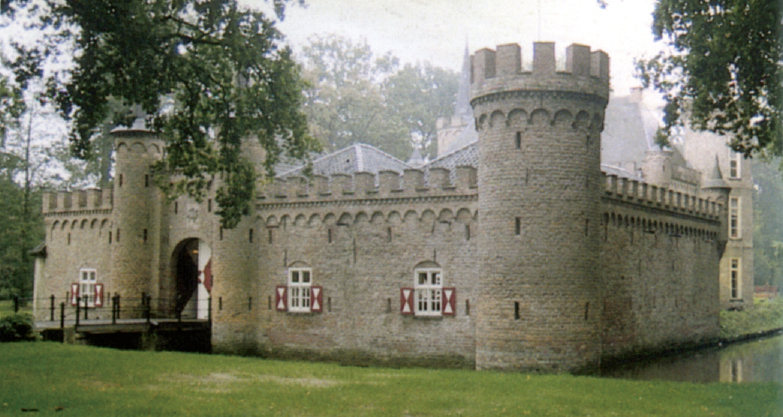
Castle Henkenshage

501st Geronimo Memorial, Eerde with windmill in background
Return to the N265, turn left direction Veghel and continue to the traffic lights at the turning to Eerde and turn left on Eerdsebaan. Continue through the centre of the town to the church on the right and stop.
The road runs along the southern boundary of 101st AB DZ A.
• Graves of 44th Royal Tanks, Eerde Churchyard/53.9 kms/33.7 miles/10 minutes/Map 1S/73
In the churchyard behind the church, half-way up on the right-hand side, are the well-tended graves of the five 44th Royal Tanks men described on the memorial below who lie side by side.
Continue to the Memorial at the T-junction ahead.
• 501st Geronimo Monument, Old Mill, Eerde/54.2 kms/33.9 miles/10 minutes/Map 1S-74/75
In the sand dunes of Eerde between Veghel and Schijndel the 501st PIR waged bitter hand-to-hand fighting with the Germans and sustained heavy losses in their efforts to shield The Corridor. In 1981 this exuberant memorial, with the colourful badge of the regiment showing the head of the Apache Geronimo (their battle cry) surmounting a brick base, was unveiled. To the right of the main memorial is a pillar with the names of eleven Americans erected ‘To my friends, may they rest in peace’ by William and Thelma McMahon in 1989. On the adjoining mill are several plaques. There is a list of names of the dead of the 501st and the story of Sergeant Jacob H. Wingard who at about 11 o’clock on 18 September 1944, was killed in the windmill and is now buried in Margraten US Cemetery (qv). Between the windmill and the nearby house a British Sherman tank was knocked out during the fight on Sunday 24 September 1944. The names of British soldiers of the 44th Royal Tank Regiment, killed on 24 September, are listed: Trooper Gilbert L. Astin, age 21; Trooper Jasper Jones, age 27; Trooper Frank W. Stacey, age 36; Trooper James E. Hardy, age 30, and Lieutenant Wallace R. Hooper, age 28. They are buried in the churchyard you have just passed.
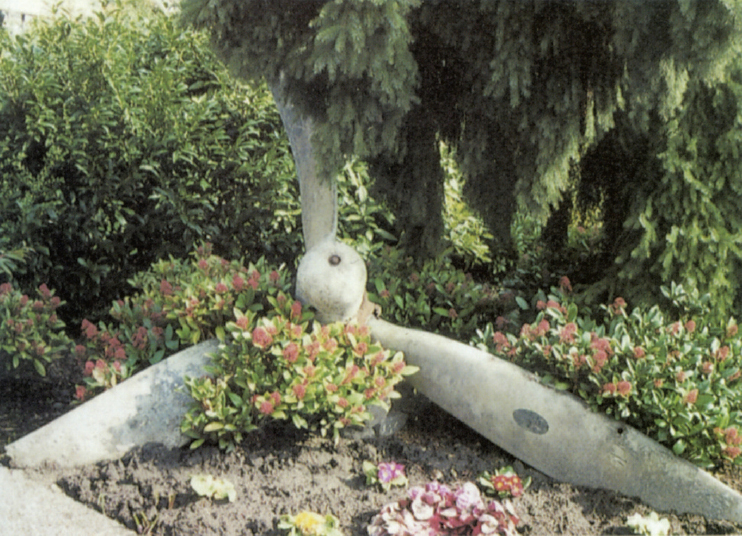
St Oedenrode; C-47 Propeller / Thorogood and Matthews Memorial
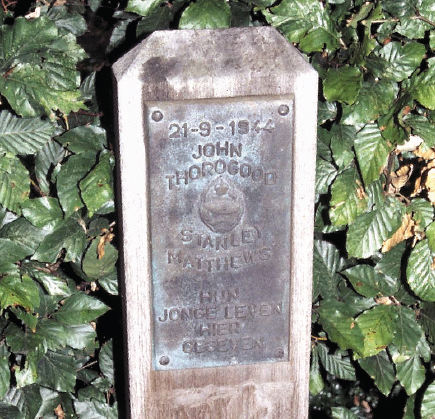
Every 17 September (or the nearest Sunday) local dignitaries and members of local Remembrance Associations lay flowers at the memorial and deck the mill with WW2-related decorations - dummy parachutes and paratroopers, model aeroplanes, flags etc. Any visiting veteran groups are received with enthusiasm
Return to the N265 OR
• Long Extra Visits to Schijndel 51st Highland Division Memorial and ‘Mother Hen/Bird of Prey’ (Map 1S-76/77); St Michielsgestel Liberation Memorial, Memorial to Civilian Victims and RAF Graves (Map 1S-78/79/80; Vught - Student’s HQ, 51st Highland Division Room, National Monument (Concentration Camp), Fusilladeplaats Memorial, (Map 11-113,1S-83/82), Den Dungen Silent Wings Memorial (Map 1S/84); Heeswijk Liberation Chapel, Kasteel Heeswijk Landings Monument, (Map 1S-85/86) Round trip: 64 kms/40.3 miles. Approximate time: 2 hours 45 minutes
Continue to the junction with the N265 (N622) and turn left direction Schijndel. Continue through Wijbosch and at the traffic lights at the first major junction turn left signed St Oedenrode (3.2 kms/2 miles). Continue over the roundabout to the group of statues on the right at the traffic lights. Turn right and stop in the slip road behind the memorial.
51st Highland Division Memorial Statue (5.1 kms/3.2 miles).
To British eyes, this is probably the most beautiful traditional war memorial in Holland. It is a statue of a kilted Highlander looking down on a delightful young Dutch girl. The attitude and facial expression of the figures tell all there is to say about Liberation: the happy, trusting face of the girl, the dependable, strong yet gentle face of the soldier. It is reminiscent of the Highlander at the head of Y-Ravine in the Beaumont Hamel Park on the Somme.
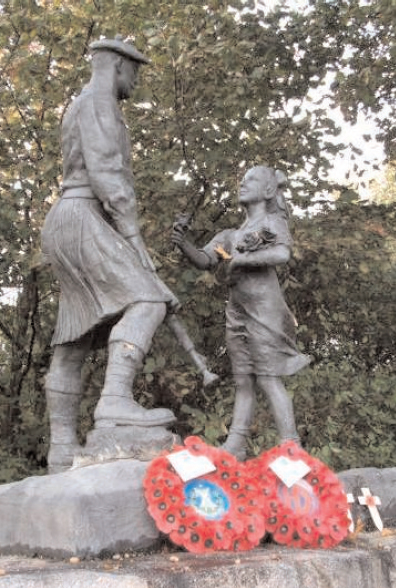
51st Highland Div Memorial, Schijndel
The legend on the memorial describes how on 23 October 1944 the 51st Highland Division launched an offensive from this position. By 7 November the enemy were cleared from the 800 square kms south of the River Maas between Schijndel and Gertruidenberg. Its casualties were forty-four officers and fifty-three soldiers. 2,800 of the enemy were taken prisoner.
On the 50th Anniversary of the Operation codenamed COLIN and GUY FAWKES veterans were welcomed back by the Dutch and this statue was unveiled. The base is made of Scottish granite and a panel shows the towns which were liberated, when, and by which Brigade. Above them is the Highland Division emblem and below the Gaelic motto which translates, ‘Friends are good on the day of the Battle.’ The designer was Alan B. Herriot. Below the memorial is a large ‘HD’ in green box hedge.
Miniature versions of this group of statues may be seen in the 51st Highland Division Room in Vught (qv) and in the Director’s office in the Museum at Best (qv).
Return straight over the roundabout and straight across the traffic lights, direction Schijndel to the next roundabout with the large tulip sculpture, turn left signed Centrum to the crossroads with Hoofdstraat, turn right and then, after the large church on the left, immediately left onto Jan van Amstel Straat. Continue to the St Lidwina Convent grounds on the right. Drive over the small bridge into the grounds and park. Walk to the left round the main building and through the housing complex to the grassed area at the back - Veronica Park. In the park is
Monument to the Sisters of Love, Lidwina Convent, Schijndel. (10.5 kms/6.6 miles). In September 1944 many of the paratroopers and gliderborne forces who landed or dropped in Brabant were off course and found themselves stranded in enemy territory. In many cases they were hidden and fed by the local citizens, who thus risked their own lives. In the Lidwina Convent, in the midst of the occupying Germans, 27 Americans who landed in the vicinity were sheltered and cared for by the Sisters of Love until October 1944. In 1984 this imaginative and symbolic bronze memorial by Dolf Wang was erected to the Sisters. It depicts a mother hen protecting her chicks from a bird of prey.
Return to the large church and turn left on Boschweg. Continue to the traffic lights and junction with Structuurweg. Turn left direction St Michielsgestel and continue to a left turn signed St Michielsgestel (14.6 kms/9.1 miles). Turn left along Gestelsweg which becomes Schijndelsweg and after passing the town sign take the first turning right on Spijt and immediately left into the slip road. On the right is
Memorial to Sint Michielsgestel’s Liberation on 23 October 1944 by the 1st Northants and 7th Black Watch (16.2 kms/10.1 miles), erected in May 1985. There are seats each side of the memorial and a post for hanging wreaths with two Northants Yeomanry plaques (May 1985 and October 1994).
Continue towards St Michielsgestel Centre and turn right into the main square.
In the square is an interesting ancient tower, some pleasant cafés and restaurants and the Town Hall (16.6 kms/10.4 miles), inside which there is a Display Cabinet with mementoes of the 51st Highland Division, the US AB Divisions and the Poles, visits of various veterans’ groups etc. Market Day is Friday.
Continue to the large church on the right. Stop. In front of the church on its left is
Monument to Citizens of Sint Michielsgestel Shot by the Germans. This sad memorial was erected in 1984.
Continue just beyond the cemetery on the right and stop (173 kms/10.8 miles).
There is a CWGC sign at the entrance.
On entering the cemetery, immediately turn to the right corner.
There are the 4 graves of an air crew, all dated 19 September 1944. They are Flight Sergeant G.S. Breckels, RCAF, Air Gunner, age 19; WO S. H. Coeshott, RAF, Pilot, age 23; Flight Sergeant S.V. Davis, RAF, Navigator, age 21, and Flight Sergeant J.G. Jeffery, RAF, Air Bomber, age 22.
N.B. To the right past the cemetery is the Beekvliet building. During the war it was a Seminary and the Germans used it as a Transit Camp for Concentration Camps in Germany.
Turn round and return to the square. Turn right at the T-junction signed Vught. Cross the Dommel.
This is a new bridge, built in 1970.
Turn right direction Vught, continue over the A2 motorway and enter Vught on Haldersebaan, turn left signed Vught-Zuid, on Glorieuxlaan and after about 100m, turn left into the Landgoed Huize Bergen Conference Centre.
In September 1944 this was General Student’s HQ (qv) (22.4 kms/14 miles). He left Berlin on 5 September for Tilburg. On the 14th he moved his HQ here and on 15 September the double agent Lindemanns (King Kong) reputedly came to see him with his latest intelligence report about Allied movements. Although it is always recounted that it was at Vught that the crashed glider containing the Allied plans for MARKET-GARDEN was found, the precise site has not been identified.
Turn round, return along Glorieuxlaan, straight over the traffic lights signed Vught Centrum and follow the road left along Boxtelseuvg.
In the Park Reeburg to the left is a Memorial Urn to the Women Prisoners of Vught who were killed in Sachsenhausen Concentration Camp.
On the left after the park is the back of Vught Town Hall, looking like a fairytale castle.
Turn first left after the town hall along Leeuwensteinlaan and first left along Radhuisstraat. Stop by the Town Hall.
To the right of the main entrance is an ‘Information Sign’. Round the corner is the entrance. 51st Highland Room. Vught Town Hall (23.4 kms/14.6 miles). On the first floor of this picturesque building is a unique room devoted to the 51st Highland Division. Around the walls are photographs of veterans of the Division, many taken during pilgrimages to Vught. There is a glorious stained glass window dedicated to the Division, 26 October 1944, a miniature of the Schindel Divisional Memorial, an interesting wooden ceiling incorporating a clock.
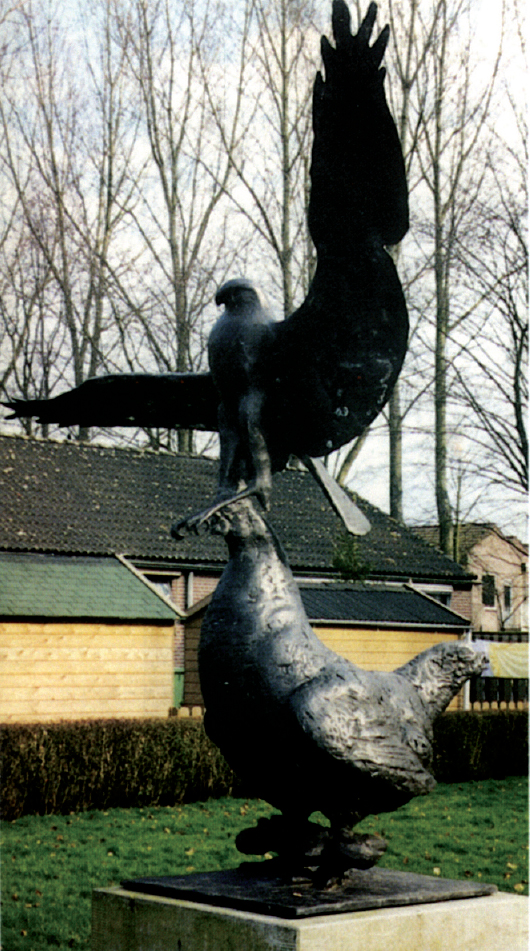
Protective Mother Hen Memorial, Schijndel

Sint Michielsgestel Memorials: Liberation by 1st Northants/7th Black Watch, and Shot Civilians
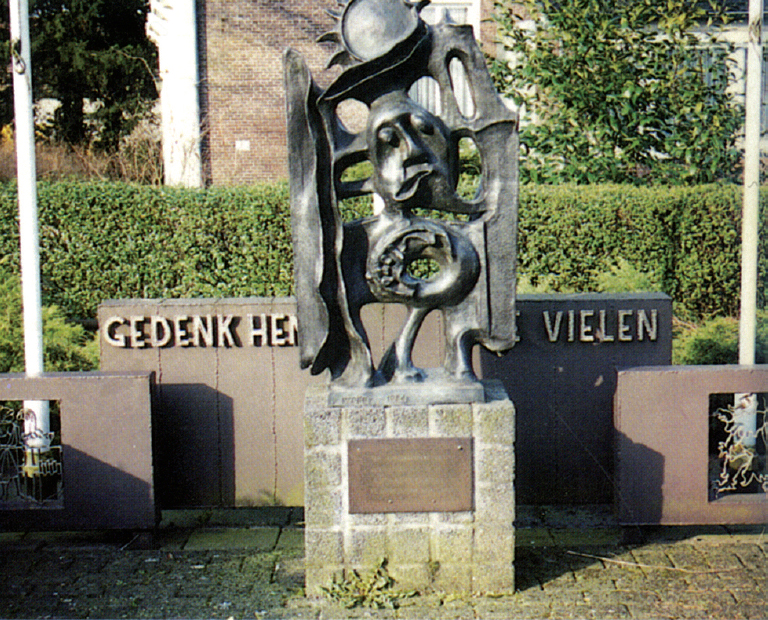
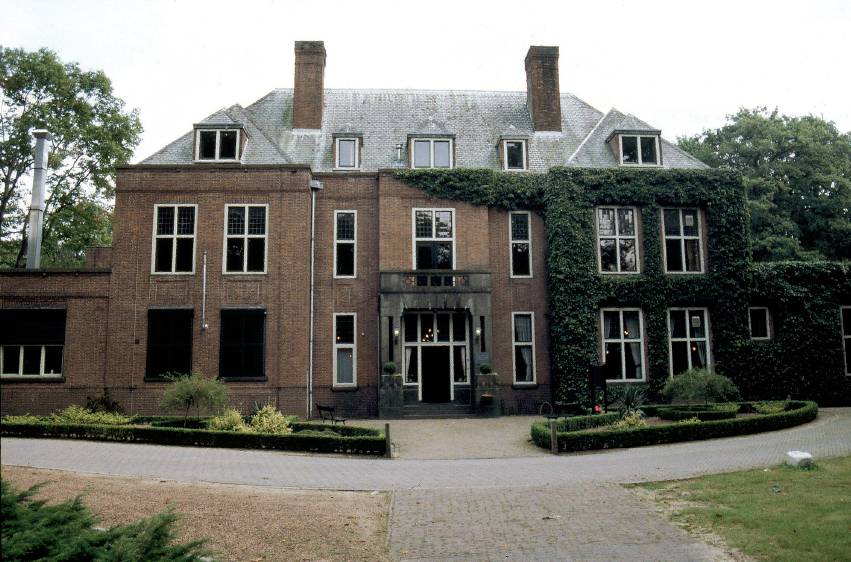
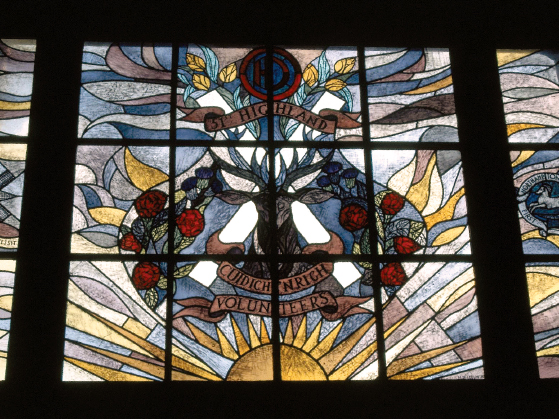
Vught: Gen Student’s HQ and 51st Highland Div stained glass window, Town Hall
Above the main entrance is a fine stained glass window dedicated to the Red Cross and by the front door and on the landing on the stairs are Memorials to Belgian Political Prisoners.
N.B. Prior permission to view the Scottish Room must be obtained, as it is a working meeting room and may well be occupied, either by going to the Information Office at the side of the building (see above), which is highly recommended as one can obtain a useful, detailed town plan here, or by telephoning in advance on + (0) 73 6580620.
Turn round and continue along Radhuisstraat, then turn left immediately before St Petrus Church onto Ploegstraat and stop. In the church is a
Stained Glass Window in Memory of the Solidarity of the Women of Kamp Vught (23.8 kms/14.9) by Marius de Leeuw, inaugurated in October 1996.
Continue and turn right on Kloosterstraat following the one-way system. Turn left and then right on Koestraat.
N.B. By going straight on here the Station is reached. In the Station to the left is a plaque, unveiled by Princess Juliana on 23 October 1984, to the 14,000 Jewish men, women and children who were transported to Concentations Camps and near it is a memorial to the Belgian Prisoners of Kamp Vught. Twenty were hanged in the camp in September 1943 (Map 11/5).
Continue to the next junction (24.2 kms/15.1).
N.B. To the right at the end of Taalstraat is Vught Historical Museum. It contains a permanent exhibition on the Concentration Camp, sometimes known as ‘Konzentrationslager Herzogenbusch’, but better known as Kamp Vught. Open: Sunday, Tuesday and Thursday 1400-1700. Admission free. Tel: + (0) 73 65 66764 (Map 11/6). www.nmkampvught.nl
Turn left on Helvoirtseweg, over the railway to the traffic lights and turn left on the N65, direction Tilburg. Continue to the traffic lights and turn right signed Cromvoirt/National Monument on Boslaan. The first turn to the right after crossing the railway is signed to
Fusilladeplaats (Mur des Fusillés). The memorial wall is on the site where hundreds of prisoners were brought to be shot by firing squad. It was unveiled by HRH Princess Juliana in 1947 and on it are inscribed the names of the 317 whom it is known for certain were shot here in July, August and September 1944. Many other unknown prisoners were shot here. Behind the wall is the sand hill that the Germans used as a ‘safety net’ for stray bullets. On 7 May 1995, vandals smeared panels on the memorial with tar. These desecrated panels were removed and now stand, encased, near the symbolic camp gates in the National Monument. The Memorial was restored and reopened in 1966.
Continue with the De Ijzeren Man lake to the left. Turn right into the Camp Vught complex along Lunettenlaan (26.6 kms/16.6 miles). Continue to the black glass command post on the left.
N.B. If you wish to visit the Engineers’ Museum, which is in the restricted military area, which includes a training centre for the Dutch Engineering Corps, to the left, you should phone in advance to + (0) 73 6881867 for permission. You must then check in at the command post, leave some identification, receive a pass which raises the barrier, and then park in the car park to the right. Someone will emerge to welcome you. www.geniemuseum.nl
To reach the Kamp Vught Concentration Camp National Monument, drive straight to the end of Lunettenlaan.
En route the Nieuw Vosseveld Penitentiary is passed on the left and there is also a Moluccan Settlement in the area. Note that the entire area you are driving through was once the Concentration Camp.
Park in the car park beyond the prison and walk to the recreated camp.
Note that there is another path signed to Fusilladeplaats here.
Kamp Vught Concentration Camp National Monument (28.5 kms/17.8 miles).
Open: 1 April-31 October every day. Tues-Friday 1000-1700. Saturday-Monday 1200-1700. Entrance is free, but there is a charge for guided group tours. Donations may of course be made.
Tel: + (0) 73 656 6764. Fax: + (0) 73 6560835.
E-mail: info@nmkampvught.nl Website: www.nmkampvught.nl
The present Monument was completed in 1990 and was opened by Queen Beatrix on 18 April that year on a small part of the vast 1943/4 camp that stretched back as far as Boslaan from which you turned into the complex. It was created as a dreadful reminder of man’s inhumanity to man and to make the visitor aware that in many parts of the world oppression, torture and annihilation still exist. It comprises a compound with recreated watch towers near parts of the original fence, within which there is a ditch. As you turn into the entrance there is a Visitors’ Centre and toilets to the left. It is highly advisable to pick up the excellent English language guide book here as the explanatory boards that mark each stop on the recommended route are all in Dutch. Ahead is a schematic model of the camp as it was in 1943. The route then takes one through the recreated wash and toilet area, an Information Centre, sleeping quarters and the crematorium, with original ovens - although Vught was not an extermination camp and there were no gas chambers; prisoners were transported to the infamous camps in Germany or Poland to be gassed and Vught was known as ‘The Gateway to Hell’. However, Himmler ordered that all prisoners who died in the camp, through whatever cause, should be cremated. There is a replica of the notorious Cell 115, into whose 9-square-metres area, the Camp commandant Grunewald crammed seventy-four women from Barracks 23b on 15 January 1944 when they protested at their barracks leader being locked up. After fourteen indescribable hours, ten women were dead, many others unconscious or out of their mind. Grunewald was later imprisoned for the atrocity.
The area thus preserved or recreated as a reminder of the obscenity of the camp’s history is small and very quiet. It vividly imparts its story. As Vught is a National Monument, funds have been allocated to make a large new, modern exhibition. It is doubtful whether it can have a greater impact than this simple memorial. By far the most moving item in the monument area is the new Children’s Memorial, inaugurated on 4 May 2000. Bronze tablets are inscribed with the names of the unbearable number of 1,269 children, with their ages. 1,800 children were transported from here to concentration camps, 1,200 on 6 and 7 June 1943 alone to the extermination camp at Sobibor. Surmounting the tablets are golden Stars of David, and on a ledge at their base are bronze toys - a doll, a top, a truck. Visiting children today place touching tributes to these martyred young people, treasured possessions that they happen to have with them - a necklace, a pen, even prized Pokemon cards.
Kamp Vught in WW2. Building work started on the camp, officially designated Konzentrationslager Herzogenbusch, in 1942. Directly accountable to SS HQ in Berlin, it was the only camp situated outside the borders of the Reich but was laid out exactly like a German concentration camp. Barracks were about 85m long and about 13m wide. With twenty-three watch towers equipped with searchlights and machine guns, the camp was surrounded by a double barbed wire fence and deep ditch. It was used to break Resistance Workers and to house the growing number of Jews that were to be deported to camps in the Reich when transit camps at Amersfoort and Westerbork became too small. Emaciated prisoners from these were used as slave labour to complete this camp in conditions so harsh that hundreds of them died during the first few months. In February 1943 a large number of student hostages were brought to the camp and Philips (qv) workshops or labour yards were set up around the hospital. At one time there were 1,200 Philips workers, many of them Jews. By insisting that these skilled workers were needed for the German war effort, Frits Philips and his managers, many of whom worked in the camp, were able to save many of their Jewish employees from being transported to extermination camps for many months. There were also many acts of sabotage in the workshops. Local opinion about Philips’ wartime role was mixed. Some saw Frits Philips as another ‘Schindler’, others as a collaborator, although there is little doubt that there was no alternative under the Occupation but to work with the Germans as refusal to do so would have brought fearful reprisals, especially to the Jewish workers. As workers from the Eindhoven factory were occasionally allowed in, messages and gifts were smuggled in and out of Vught.
Large numbers of prisoners continued to be brought into the camp, then transported to extermination camps. In May 1944 800 prisoners were transported to Dachau. In June 1944 the last transportation to Auschwitz took place, amongst them the Philips Jewish workers. After this an important conveyor belt was cut in the Philips’ workshops and as a result the entire Philips’ management were dismissed. As news of the Allied advance through France and Belgium became known, many reprisal executions took place here. On 5/6 September 2,800 men were transported to Sachsenhausen and 650 women to Ravensbruck. The camp was then virtually empty. Part of the camp records were then destroyed and on 13 September the last members of the SS departed. On 22 September the camp was officially handed over to Sister Hulsman of the Red Cross. It was then used by the Allies as a German POW and Collaborators’ Camp.
It is estimated that approximately 31,000 prisoners passed through Kamp Vught. No record of the exact number who died exists, but it is known that 15,000 prisoners, of whom 12,000 were Jews, were deported to extermination camps where very few of them survived.
The message that the visitor to the National Monument should understand about the terror of the concentration camps is summarized by the words of Friedrich Martin Niemoller, a U-boat Commander in WW1, who became a Pastor, opposed the attitude of the Nazi party to the Church, was arrested in 1937 and imprisoned in Sachsenhausen and then Dachau before being liberated in 1945:
When the Nazis came to fetch the Communists
I remained silent
For I was not a Communist.
When they imprisoned the Social Democrats
I remained silent
For I was not a Social Democrat.
When they came to fetch the Catholics
I did not protest
For I was not a Catholic.
When they came to fetch me
There was nobody left to protest.
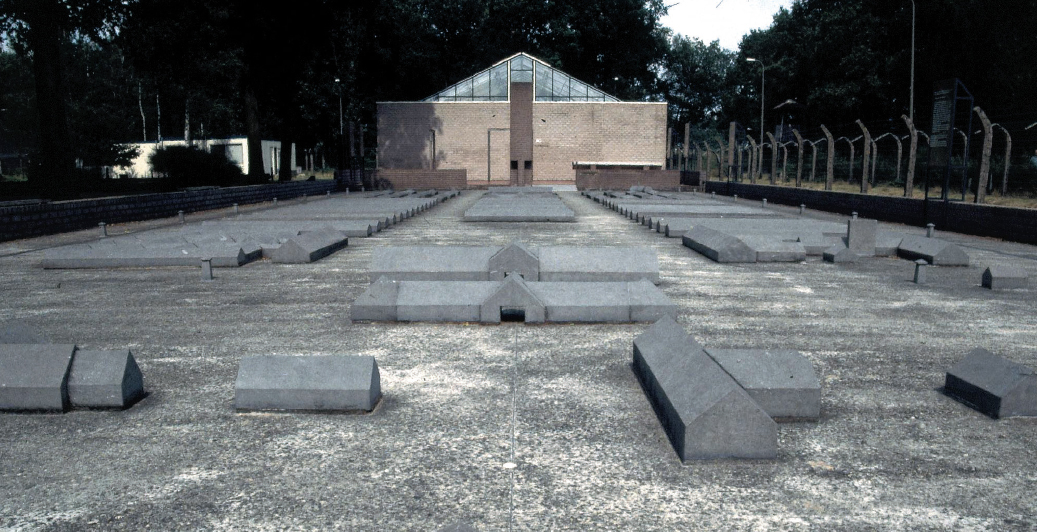
Vught Concentration Camp: recreated layout and personal tribute on Children’s Memorial
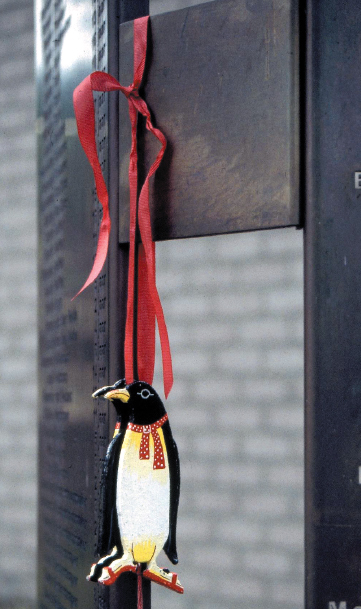
After WW2 Martin Niemoller became a controversial pacifist. In 1967 he received the Lenin Peace Prize and died in 1984.
Return to the N65 and turn left direction ‘s-Hertogenbosch. Continue onto the A2/E25 signed Nijmegen and take Exit 22, ‘s-Hertogenbosch-Centre signed St Michielsgestel.
N.B. By exiting here at Junction 24, ‘s-Hertogenbosch-Center, direction west towards Vlijmen onto the A59 to Exit No 41 Drunen and then to the centre of Elshout, an ‘Underground’ Memorial which tells an extraordinary story may be visited. Designed by P. Powels in 1994 and erected beside the church, it commemorated the Norbertinus monastery which once stood on the spot and in which thirty-two British and fifteen American Airborne men were hidden under the eyes of the occupying Germans by the people of Elshout and Drunen when their gliders were brought down between Loon op Zand and Drunen. On 21 October the men were transferred to a shelter on the Campina Heath near Boxtel, where forty-eight Americans were already hiding. On 24 October this group of hideaways liberated Boxtel, a day before it was reached by the 51st Highland Division.
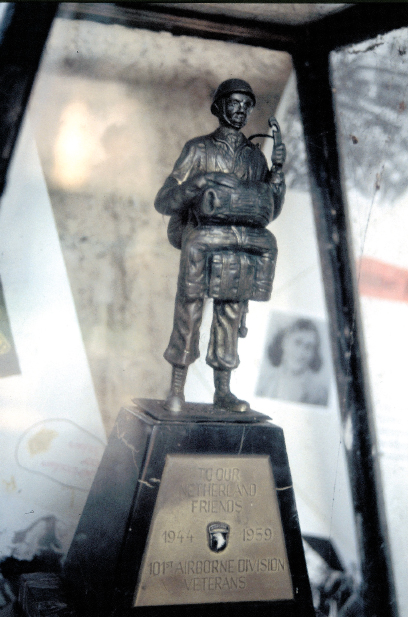
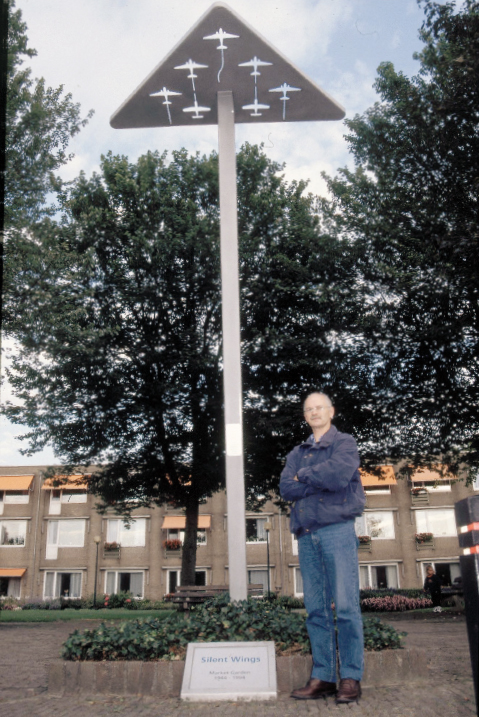
Silent Wings Memorial, Den Dungen, with designer, Jos Korsten
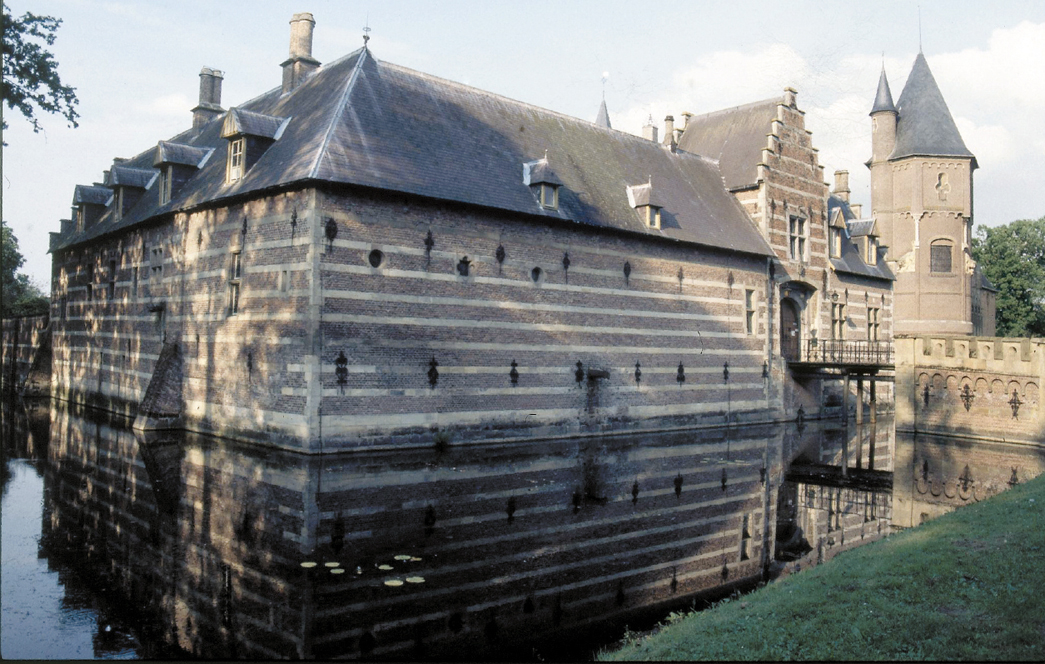
Kasteel Heeswijk with 501st PIR Memorial
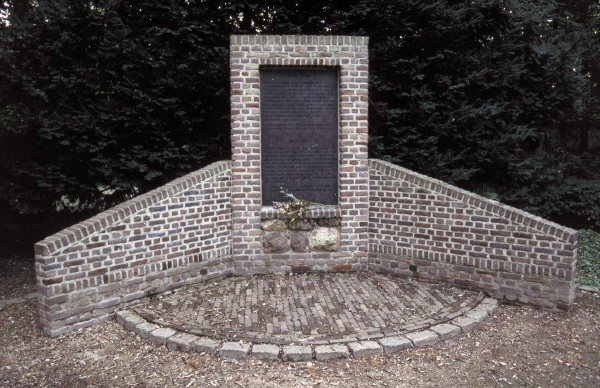
Continue and turn left at the traffic lights signed to Den Dungen and left again after the windmill. Continue past the church to the memorial on the right in the car park.
Silent Wings Memorial, Den Dungen (41.4 kms/25.9 miles). This highly original and effective memorial was designed by local teacher Jos Korsten in 1994, with the support of the Den Dungen Market Garden Committee and active member Jacq van Eekelen (author and photographer of the excellent Nord Brabant Memorials book (qv)). It tells the story of the gliders which landed in the middle of enemy territory in September 1944. As at Son, several gliders landed in the wrong location - because they were lost, cut off from their tugs or shot down. The survivors of these stragglers were often sheltered, at great danger, by the local population. Here in Den Dungen the crews of two gliders were cared for for two weeks. The memorial was located here as the triangle Vught - Den Dungen - s’Hertogenbosch was the initial aiming point for all aircraft engaged in MARKET. It was codenamed ELLIS.
A plaque on the post of the memorial tells the story of Glider pilot Dan Griffiths who landed at Den Dungen on 18 September and who was a regular visitor here after the war. In 1990 he was made a Freeman of the town. Den Dungen was twinned with Portishead, Dan’s home town, which Jos Korsten and his children often visit. Dan Griffiths died on 9 May 1998, but was involved in the erecting of the memorial before his death. It is a ‘living’ monument in that the sky is constantly changing through the cut-out shapes of the gliders. It is planned to move it to a more open site in the square, and to make a shiny marble base that will reflect the light.
Continue, crossing the Zuid Willemsvaart Canal (43.5 kms/27.2 miles) and turn right onto the N266 signed Veghel. Turn left signed Heeswijk-Dinther, continue into the village and immediately after crossing the River Aa turn right onto Mgr van Ooorschotstraat following Airborne Monument sign. On the right is
Liberation Chapel, Heeswijk-Dinther (52 kms/32.7 miles). In 1959 US Airborne Veterans raised the money for this Chapel, designed by N. Hansen and M. van Helvert. Within it is a bas relief of the Virgin Mary and a small statuette of a paratrooper and over the entry is the 101st AB’s Screaming Eagle. There are plaques to the 501st, 1969, on either side - to Heeswijk to the right and Dinther to the left, both with the date 21 September 1944. Beside the chapel is a 101st AB Memorial Bench.
Turn round and continue into the village centre towards the church. At the T-junction turn left to Berlicum on Hoofdstraat, signed to Kasteel Heeswijk. Continue past the exit Heeswijk sign to the sharp right bend and turn left to the Castle.
Landings Monuments, Kasteel Heeswijk (55 kms/34.6 miles).
This fairy tale castle has origins which date back to the 12th Century. By the 14th Century it was a walled castle and over the years passed from owner to owner. The last family to own it was the Van den Bogaerde van Terbrugge who acquired the castle in 1835 and built up an important armoury collection. Major restoration began in 1950 and the last Baron and Baroness lived in the coach house from 1974 until the Baroness died in 1994. The castle is now owned by a foundation and may be visited.
Across the bridge over the moat to the right is a memorial group erected by J. M. Driessen (qv) in 1997. A path leads to an urn, erected on 17 September 1994, on the back of which is the story of Lieutenant-Colonel Francis Sampson, Chaplain to the 101st, who landed on top of another parachutist in the moat. They managed to scramble out, but Father Sampson had to dive in again to recover his Chaplain’s equipment. Sampson, who had been captured by the Germans in Normandy but who escaped, went on to become the most senior U.S. Army chaplain, and a great personal friend of Frans Driessen. He died on 28 January 1996.
Beyond the urn is a brick memorial with a plaque which commemorates the landings around the Castle of the 1st Battalion, 501st PIR on 17 September 1944 under Lieutenant-Colonel W.O. Kinnard. They prepared the way for the advancing Allied armies and ‘took a heavy yoke of occupation away from this part of the Netherlands’. The Americans were not supposed to land here but were off target. Kinnard left a small detachment here and set off via Heeswijk and Dinther to Veghel where he took the town. When he returned here there was no sign of the forty-eight men that he had left, only bloodstained bandages.
Return through Heeswijk-Dinther to the N266 and turn left signed Veghel.
The area to the right between the village of Dorshout and your next turning was DZ A where the 501st PIR landed (minus Lieutenant-Colonel Kinnard and his men!)
Continue over the railway and immediately turn left into Veghel.
Just before turning the Veghel bridge over the Zuid Willemsvaart Canal can be seen 600m ahead - it is crossed on the main itinerary and was one of the American targets for 17 September).
Continue to the roundabout and go straight over signed Centrum onto Hoogstraat. Turn right onto Colonel Johnsonstraat and stop at the memorial which is where you rejoin the main itinerary. (64 kms/403 miles).
The only thing that you have not done by taking the Extra Visit is to drive over the Veghel Bridge.
Turn left towards Veghel.
The area to the left of the road is DZ A where the 2nd and 3rd Battalions of the 501st PIR landed.
• Veghel Bridge/58 kms/36.3 miles
This bridge, now modernized, was taken by 501st PIR within one hour of their landing despite one battalion being dropped at Kasteel Heeswijk (see above) almost 5 kms off target. Its commander, Lieutenant-Colonel Harry W. O. Kinnard Jr, ordered a small group to stay and guard the equipment and marched the rest of his men off at high speed to Veghel where they quickly overcame a detachment of Korps Feldt (qv).
Cross the bridge and take the exit signed Veghel. At the next crossroads turn left signed Centrum back under the N265 and continue following signs to Centrum, keeping to the right at the roundabout, into Hoogstraat. Continue to the right turn onto Colonel Johnsonstraat and stop just beyond it. Walk back round the corner to
• Veghel Airborne Memorial/Dutch East Indies Memorial/‘Klondike’/59 kms/37miles/15 minutes/Map 1S-89/90/91
The 101st AB Division memorial is in the form of a kangaroo with a baby in her pouch (symbol of the Allied forces leaping over the Dutch rivers) on a huge stone block, which weighs 1,200kgs. It was designed by Neil Steenbergen. Note the small bronze figure of a parachutist on the right of the block which records the fact that the monument was unveiled by HRH Princess Irene of the Netherlands on 17 September 1959. There is also a plaque on the ground commemorating Veghel’s liberation on 17 September 1944 by 501st PIR with other units and the intense battle of 22-26 September. Under a stone is an urn containing soil from the fifty States of the U.S.A. Beside the memorial are two benches donated by Friends of the Airborne. Each 17 September, or the nearest Sunday, wreaths are laid and flags are flown at the memorial. Any visiting veterans are royally welcomed and entertained by local Associations for Remembrance.
The primary job given to 101st AB Division had included capturing the bridges and keeping open 25kms of The Corridor north of Eindhoven to just beyond Veghel. The bitter struggle to fulfil their task prompted the paratroopers to christen the road ‘Hell’s Highway’. General Browning’s original plan called for a scattered drop along The Corridor, but General Taylor, remembering the near disaster of the Division’s dispersed drop in Normandy, protested. After an appeal to General Dempsey the plan was changed to make drops in two principal areas, one just north of Son, the other immediately south of Veghel [Sketch Map 1]. The capture of Eindhoven was to be a secondary objective. On 17 September, between 1300 and 1330 hours, 6,769 men of 101st AB jumped into Holland, 425 planes out of 428 finding their DZs. One hour later, but less successfully, fifty-three of the seventy gliders that left England arrived. They brought thirty-two jeeps but no artillery, since General Taylor felt mobility was more important than firepower. As you face the memorial from Colonel Johnsonstraat (named after Colonel Howard R. Johnson, commanding 501st PIR, who was killed during the fighting in ‘The Island’) the Americans came in both from your left and your rear. They achieved all their objectives within three hours and took fifty German prisoners. The bridges over the River Aa and the Zuid Willemsvaart Canal were reinforced with the help of local people to take the weight of the Allied tanks.
Beyond the monument is a grey stone Memorial to Veghel Military Members who died in the Dutch East Indies 1943-1949, erected in 1994. The house opposite bears a large green kangaroo on its front wall.
The large brick building on the corner of Hoogstraat and Colonel Johnsonstraat was used as an American HQ when the owner, Doctor Kerssemakers, placed his house at Colonel Johnson’s disposal. The word ‘Klondike’, codename for the command post, is incorporated in the ornate wrought iron gates, there is a plaque near the front door and on top of the ornamental facade there is a ‘Screaming Eagle’.
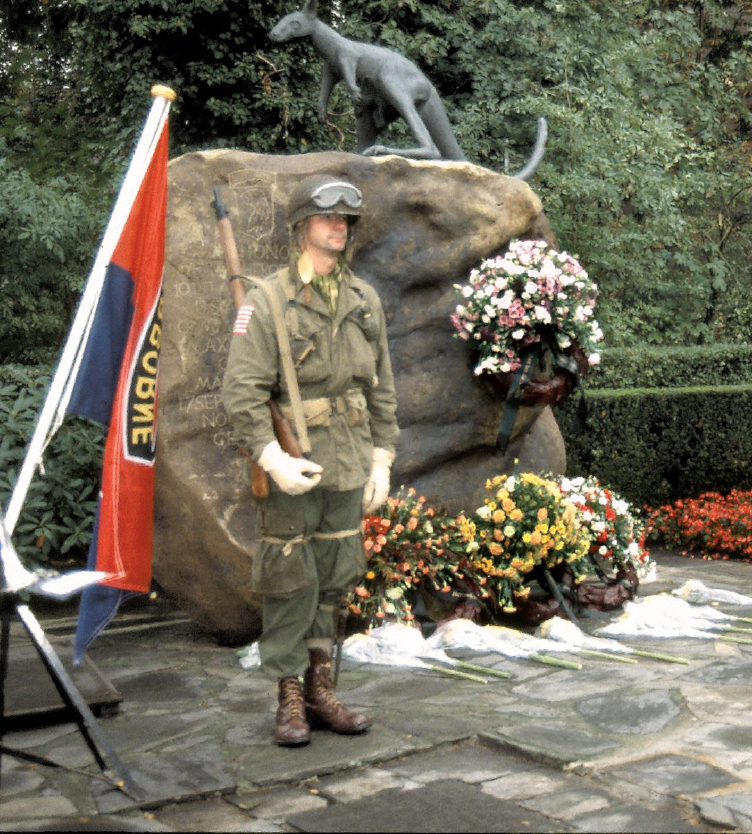
Veghel 101st AB memorial on 17 September with detail of parachutist
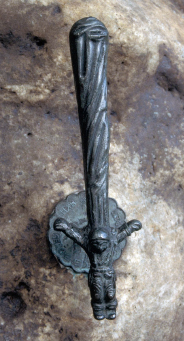
N.B. By continuing up the road the Market Square, with many cafés and restaurants, is reached. To the left is Veghel Roman Catholic Churchyard. To the right of the church is the entrance to the churchyard in the far right-hand corner of which is buried Private Allen Middleton, l/6th Queen’s Royal Regt, age 20, 30 September 1944. There is also 1 Unknown British soldier and 1 Unknown Polish Airman. On his grave is a plaque with the name T. Kozontksi, 2 October 1944. The small plot is beautifully tended (Map IS/92).
Between just below Veghel and Grave, the northern tip of 101st AB area, was a 20kms gap. The only way it could be controlled was by establishing road blocks at top and bottom. This was done, yet hardly 12kms to the west of the 101st DZs around Veghel, in Vught [Sketch Map 1], was the HQ of General Kurt Student (qv), Commander of the German 1st Para Army. Not only did he watch the airborne drops, but by 1500 hours that day he had a copy of the MARKET-GARDEN Operation Order, taken from a crashed American glider. Strangely, although he had commanded the German airborne assault on ‘Fortress Holland’ in May 1940, the first successful airborne operation in history, General Student did not sense any immediate danger. Once over his surprise, however, he reacted quickly. By an odd twist of fate, the arrival of the airborne forces had been seen by both of the German Generals most fitted to oppose them - Student at Vught and Model at Oosterbeek.
Return to the N265 and turn left towards Uden.
In the German raid on Eindhoven on 19 September eighteen RASC lorries in one convoy loaded with ammunition and small arms were destroyed, the wreckage blocking The Corridor road north. Household Cavalrymen and civilians cleared the road and set the convoy moving again but it was not out of trouble. On entering Uden the lead vehicles took the wrong turning - that to the left to Nistelrode (the N50) which led directly to German lines at Heesch. Realizing the mistake, Major Ward of the Household Cavalry decided that the column must be turned around and the following account is given in The Household Cavalry at War by Roden Orde,
Not only was the cobbled road barely wide enough to take two lines of traffic but from both verges there was a six-foot drop into a ditch … drivers said that there was not enough room in which to turn without going over the bank. One mistake and we should be confronted with the unpleasant prospect of half the column facing one way and half the other, neither being able to move… . The next few hours were to be an ordeal of bent wings and dented radiators.… [The] Grave bridge…was reached at dawn [20 September].
Continue on the N265 to the junction with the N264.
N.B. By taking the N264 and continuing into the Volkel Military Airbase on Zeelandse Dijk, the Historical Typhoon Room, opened in September 1992, may be visited. Report to the Info Centre in front of the main gate (Map 1S/93).
Please note that the room is only open to the public every first and third Friday of the month between 1400 and 1600 hours and the visit should be booked at least 24 hours ahead with Vliegbasis Volkel, Zeelandsedijk 10A, Postbus 10150,5408 ZW Volkel, Netherlands.
Tel: + (0) 413 276601. Fax: + (0) 413 276600.
The permanent exhibition is well worth a visit. It contains authentic documents, uniforms, aerial photos, military equipment, various aircraft parts and video footage. It covers the construction of the German Nachtlandeplatz (night-landing airstrip) Volkel and its development into a fully-fledged Luftwaffe airbase. Then on 19 September 1944 a reconnaissance party of two armoured cars of 16th Airfield Construction Group with Guards Armoured reported that the airstrip was much cratered from Allied bombing. Two hundred local civilians (which later increased to 1,000), were then organised to start clearing the debris from it. The speedy progress was halted when two battalions of SS troops with tanks were spotted in the vicinity. They were later attacked by Typhoons from Eindhoven. The fighting was fierce and fluid between Uden and Veghel, with the Allies (including elements of the 101st AB) struggling to keep The Corridor open from frequent attacks by German tanks. Eventually a grass strip was operational on 26 September, and a brick strip on the 28th large enough to accommodate three wings, including Typhoons, Tempests, Spitfires and Mosquitos.]
Continue past the windmill and the rugby ground, direction Nijmegen, to the traffic lights (signed to the N265 to the left) and then turn right to Uden following Centrum and green CWGC signs to the church. Stop by the cemetery on the right.
• Uden CWGC Cemetery/70 kms/43.7 miles/15 minutes/Map 1S/94
Until its liberation in September 1944 Uden was occupied by the Germans and in the early years of the war British and Allied servicemen were buried in the garden of the parish priest, which adjoined the RC Cemetery. Another burial ground was needed in 1943 and the municipality acquired for this purpose the old RC Churchyard, unused since about 1918. The present cemetery is partly enclosed by the high brick wall originally built around the old church (which was burnt down in the 1870s and a new one was built elsewhere in the town) and churchyard. After the war more than 100 graves from the garden of the parish priest, and also a number of isolated graves from various parts of the commune, were moved into this cemetery.
The cemetery now contains a total of 699 Known and 4 Unknown burials, comprising 7 RN, 428 UK Army plus 2 Unknown, 183 RAF, 3 Canadian Army and 50 RCAF, 19 RAAF, 7 RNZAF and 2 Polish. They include the crew of a Halifax of 87 Squadron killed near Bredeweg (qv) when their plane was brought down on 12/13 March 1943: Flight Sergeant Fred Marean, RCAF, Pilot, age 23, Sergeant Harry Bentley, RAF, age 29, Sergeant Charley Dyer, RAF, Flight Engineer, age 32, Sergeant William McLelland, RAF, Air Gunner, age 22, Sergeant Walter Gosnell, RAFVR, Bomb Aimer, age 19, Sergeant Bernard Singleton, RAFVR, and Sergeant George Benson, RAFVR. They are buried in Plot 4, Row C, Graves 1-7. Also Flying Officer John Paape, RNZAF, age 28,15 October 1942, [4.B.9.] whose brother, Squadron Leader Arthur Paape, RAF, DFC + Bar is buried in Reichswald Forest CWGC Cemetery (qv) and Troopers John Thorogood and Stanley Matthews of C Squadron 44th Royal Tank Regiment, killed on 21 September 1944 at St Oedenrode and to whom a memorial has been raised (qv). They are buried side by side [l.D.5. and l.D.4.]. The inscription on the headstone of Captain Prince Dimitri Galitzine, 2nd Battalion the Monmouth Regiment, age 26, 26 October 1944, is in Russian [3.D.I.].
The cemetery has voluntarily been looked after with wonderful devotion for more than half a century by the couple who live in the house opposite - Mr & Mrs Ties Verstegen. They greet visiting relatives, invite them into their house for refreshment, correspond with them, place flowers on graves for them and all the time keep a growing dossier on the men buried in the cemetery, which is now in a series of folders with photographs and biographies of many of them. Eventually they were supported by a committee which developed into a Foundation. The Foundation has published an excellently researched, detailed book by A. Verbakel, entitled Lest They be Forgot on the history of the Uden War Cemeteries and the men buried in them. Most extraordinary are the accounts of how the Germans, according to the Geneva Convention regulations, undertook the burial of Allied Airmen. Alerted to a crash, they would arrive at the site, search for any survivors, look for any signs of identification and note them, put any bodies into coffins, take them into the old mortuary in Uden and then march in a funeral procession with the coffin to the cemetery. A German Chaplain made an oration over the grave, flowers were placed on it and a salute was fired over it. Local people were co-opted to dig the grave, supply the flowers, the deal coffins and the simple wooden crosses. The municipality bore all the costs. The remains of the wrecked plane or glider were taken to the workshops in the Concentration Camps at Vught (qv) or Amersfoort to be recycled.
Return to the N265, turn right and continue to the roundabout at the junction with the N324.
• Extra Visit to the Monument to Airstrip B-82 (Map 1N/1) Round trip: 11.2 kms/7 miles. Approximate time: 20 minutes
Go straight over, signed Nijmegen/Ravenstein. After 2.6 miles turn right signed Overlangel and Neerloon, then right signed Reek, Grave, and turn sharp left at the top of the dyke signed (on the back of the sign you can see ahead) to Neerloon. Continue to a farm on the left called the Oude Maas Hoeve and turn right on the small road signed to Keent. Stop at the memorial some 110m on to the right (5.6 kms/3.5 miles).
The Germans constructed an emergency airstrip in the old forelands of the Maas at Keent, which they never used. In September 1944 it was discovered by paratroopers of the 82nd AB, but for one reason or another it did not come into use until 26 September. On that day 209 C-47 Dakotas of 52nd Wing, 9th Troop Carrier Command, landed at Keent with troops and supplies for the Americans and the 2nd British Army. Although marshy and soggy, the airfield continued to be used by fighter squadrons of 2nd Tactical Airforce. The distinctive memorial, showing aeroplanes flying off a spiral spring as if they were circling around the airstrip, was designed by Albert Sanders. To the right of the metal memorial on the ground is an explanatory plaque with a diagram of the layout of the airstrip on this ‘Hot spot’. This simple, but inspired, memorial, captures the spirit of the planes that landed on this forlorn, precarious, sodden airstrip.
Return to the roundabout with the N324 and pick up the main itinerary.
Turn right, passing a white windmill on the right, and continue to the third turning to Grave. Turn right at the traffic lights, passing an old cannon on the left.
Grave is a delightfully picturesque and historical town, whose new developments have been sympathetically designed to blend in with the old. (Note. From this point the effects of the 2012 road changes should be minimal.)
Turn left on Hoofschestraat and on the left opposite house No. 43 is the courtyard of a new housing complex. On the red brick wall of the old Infirmary is
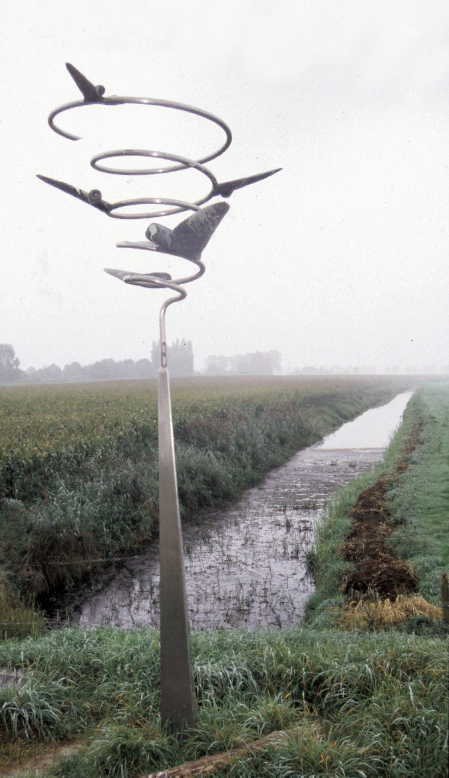
Spiralling Wings Memorial to Airstrip B-82, Keent
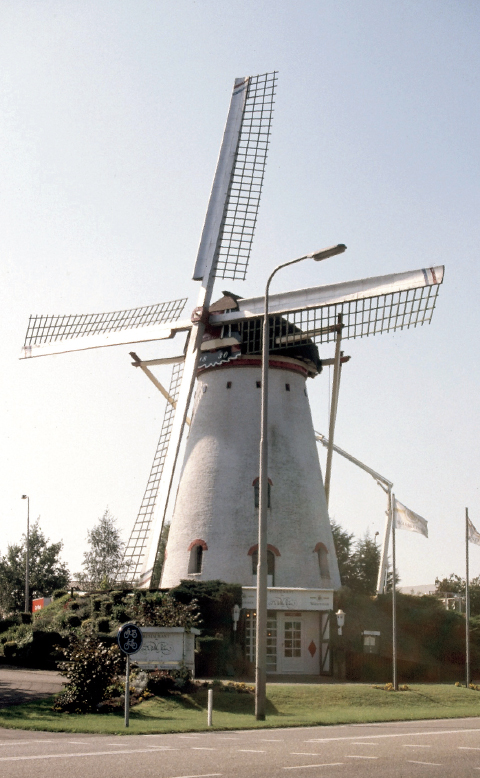
Typical windmill on the N265/N324 roundabout
• Memorial to the Border Battalions, Grave/87 kms/54.5 miles/5 minutes/Map 8/1
A bas relief by Jan Kettering shows a soldier of the battalion guarding the town of Grave. It was erected on 31 October 1964 and its caption is ‘We went and came back after years’. Grave had been a garrison town for several centuries until the troops left in 1892. In 1938 the Army returned as the Low Countries began to fortify their defences against German military aggression in her desire for Lebensraum. In Holland pillboxes were constructed close to the bridges over the major waterways, which were at first occupied by the Military Police. Border Battalions were then formed and mobilized in 1938. Those guarding the Meuse-Waal Canal came under the commanding officer stationed in Grave.
Continue, bearing right on Ruijterstraat to the large brick gateway, the Maasport, at the river bank. Park and walk to the wall to the right of the gateway.
• 504th PIR Memorial, Maasport, Grave/87.5 kms/54.7miles/10 minutes/Map 8/2
This imaginative memorial, in the form of a parachute canopy draped over the wall of the bastion, was designed by Marcel Joosten and erected on 4 May 1987. It commemorates the airborne landings along the MARKET-GARDEN corridor at 1300 hours GMT on 17 September 1944, in particular the 504th PIR, 82nd AB Division, which landed on both sides of the Grave Bridge. The caption translates, ‘From Massachusetts to California young Americans, some of them still kids, came here to give us freedom. All American - we shall never forget them.’ The bridge was taken by E Company of the 504th under Lieutenant John S. Thompson (qv) and when they came under fire from Grave town he sent part of his force down to the crossroads south of the bridge to form a road block. D Company of the regiment mthen came over the bridge and, despite heavy machine-gun and mortar fire, cleared the town.
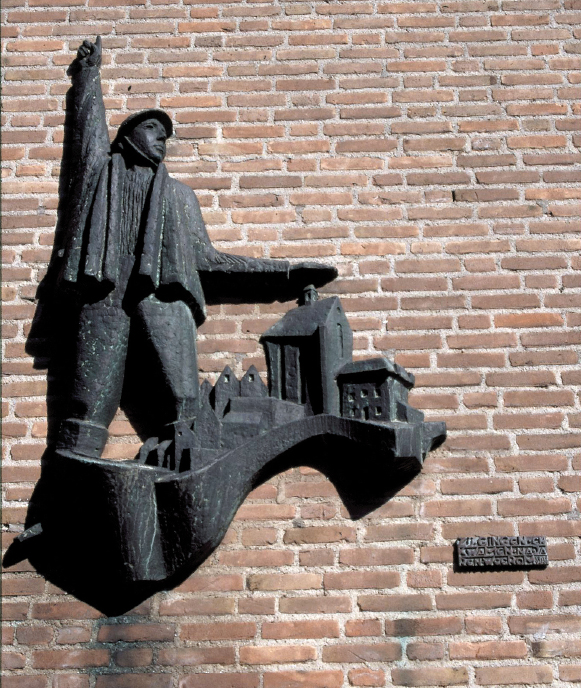
Grave Memorials: Dutch Border Battalion. Maasport Parachute and ‘Cider-White’ Plaque
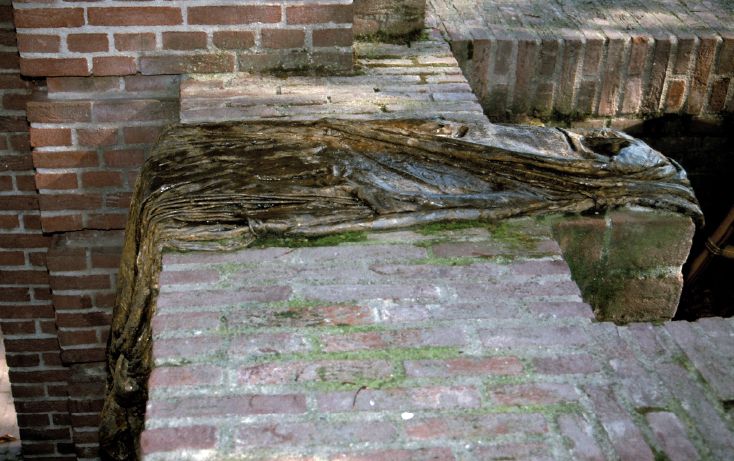
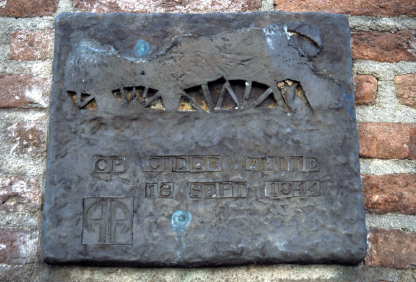
Turn round and drive back down Hoofschestraat. Turn 1st left and park near the church.
The VVV adjoins the church. Opposite is the old town hall. On 17 September the 400-strong German garrison beat a hasty retreat and, once the remnants had been overcome by D Company, the villagers had a celebration sing-song in the town hall, including the Dutch version of ‘Tipperary’. On its wall are:
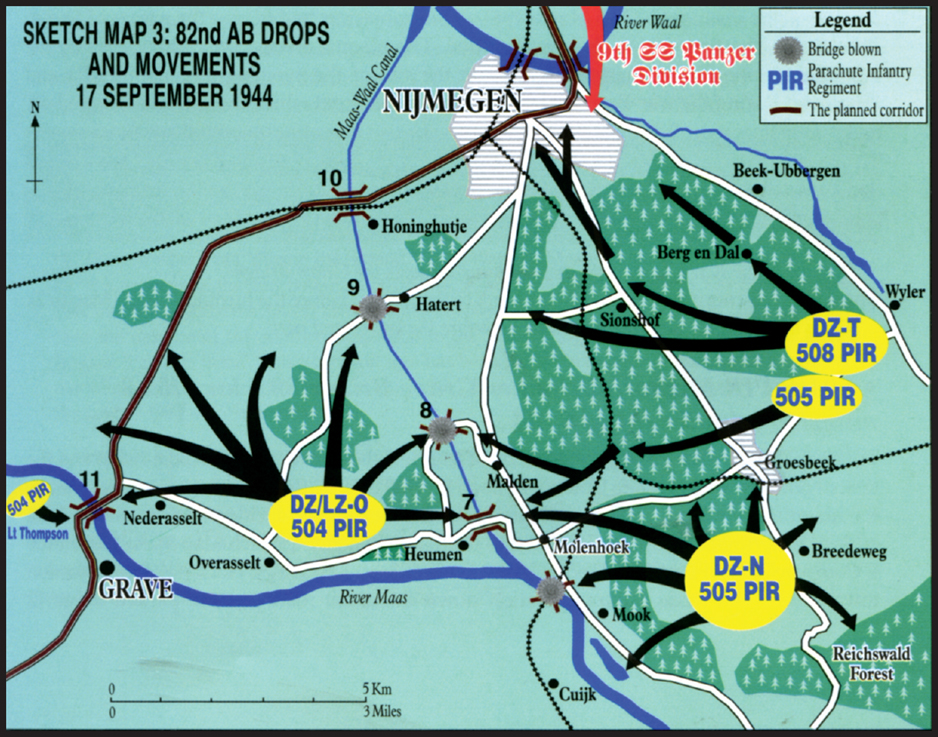
• Grave Town Hall Memorials/88 kms/54.9 miles/10 minutes/Map 8/3
1. A plain stone tablet commemorates the more than thirty inhabitants of Grave, Velp and Escharen - soldiers, civilians, including Jews - who died during the five years of war from battle, bombing (at Nuland on 11 May 1940 and in Nijmegen on 22 February 1944) and in concentration camps (e.g. Dachau and Menado). The tablet was erected by F. A. Smits & Zonnen on 4 May 1987.
1. The ‘Cider White’ (2nd Battalion 504th PIR). The bas relief of stylised parachutes and the recumbent figure of a paratrooper, designed by A. Sanders and erected on 4 May 1987, commemorates the fact that, after the Meuse bridge had been captured intact during the afternoon of 17 September 1944, Grave was reached by nightfall. It was taken about midnight. The town hall then became the command post of the battalion, whose radio code was ‘cider’ and who, as the second battalion of the regiment, had the codename ‘white’, the first being ‘red’ and the third being ‘blue’.
3. Plaque to Louis Ficq, burgomaster of Grave, who died in Dachau on 9 March 1945. Designed by F. Vervoordeldonk, it was erected in 1946 and recounts how the burgomaster was arrested by the Germans on 3 February 1944 for his public testimony to Queen and Country.
Walk along the street to the junction with the main street and take the small road straight ahead. Turn right at the end. On the wall of the corner building is
• Plaque on Site of old Grave Synagogue/10 minutes/Map 8/4
From July 1940 freedom of action of local Jews was restricted and Jewish civil servants and teachers were dismissed. On 5 March 1941 all burgomasters had to give the names of Jewish inhabitants, the first step to their persecution. The plaque, erected on 16 May 1981 by the Amsterdamsche Binnenvaartsocieteit, is on the site of the synagogue, built in 1871 and destroyed during the war. Beside it is an original stone, from which the text was chipped off.
N.B. Grave Roman Catholic Cemetery lies 1km to the south-east of the village, on the south of the road to Gennep. In it are buried 3 British airmen: Sergeant Albert Collyer, RAF, age 25, 12 April 1945; Pilot Officer Patrick Culligan, RAFA, age 21, 26 March 1945 and Flight Lieutenant Oliver Lee, age 34, 2 October 1944.
Return to the N324, turn right and continue towards the Grave Bridge.
There is a well-concealed bunker in the bank to the left just before the turning ahead. (Map 6/2).
Turn left down the slip road immediately before the bridge and park. (See Update Page xi.)
• 504th PIR Memorial/Bunker/Grave Bridge/89.5 kms 155.8 miles/10 minutes/Map 6-3/4
This 9-span, 600m long bridge was the most southerly objective of 82nd AB Division and the task of taking it was given to Colonel Reuben H. Tucker’s 504th PIR (who were later to make the magnificent assault crossing at Nijmegen). Colonel Tucker decided to drop men at both ends of the bridge as, he said, ‘It tended to confuse the enemy’ [Sketch Map 3]. At 1305 hours E Company of 2nd Battalion landed in the fields 600m away at 10 o’clock [take the direction towards the van Sasse pumping station down the small road you are parked on as 12 o’clock]; Lieutenant John S. Thompson and sixteen men headed for the blockhouse - they called it a ‘flak tower’ - at 9 o’clock, barely 100m from you [which you passed before turning off here] wading in water at times up to their necks. It, and the pillbox visible at 1 o’clock in the field below the memorial, had been built by the Dutch in 1936 as part of a defensive line covering major river crossings, but, although the Dutch blew the bridge in 1940, the pillbox and blockhouse were left. The Germans repaired the bridge to its original design and mounted 20mm anti-aircraft guns on the blockhouse. Lieutenant Thompson’s men were delighted to find that, as they neared it, the Germans were unable to depress the 20mm weapons sufficiently to fire at them and two quick shots from a bazooka silenced the gun. In the blockhouse they found two Germans dead and one wounded. They cut wires which might be connected to charges (there were 950 kilos of explosives under the bridge) and, using the gun, silenced the pillbox at 1 o’clock. Shortly after, a patrol of the main 504th PIR from the northern side, crossed over to make contact with Thompson’s force. The bridge was theirs. Colonel Tucker’s regiment claimed that, as they dropped onto the main DZ at 1231 hours on 17 September, they were the first Allied airborne troops to land in Holland. General Gavin was duly informed that ‘Bridge 11’ had been taken. Before leaving England Gavin had allocated numbers to all of the bridges that he was due to capture and this allowed the Americans to talk about them on the wireless without the Germans realising which bridges they were. (See Sketch Map 3 page 119)
Lieutenant Kavanagh’s troop of armoured cars of 2nd HCR reached here at 0820 hours on 19 September, having crossed the Son Bridge at 0615 hours that morning. Recce-ing ahead, they discovered that the main road bridge over the Maas-Waal at Honinghutje on the outskirts of Nijmegen (Bridge 10 - Sketch Map 3) was unusable and therefore the Grenadier Guards (who had taken over the lead position from the Irish), following some miles behind, were diverted through Nederasselt and Overasselt and over the bridge at Heumen (Gavin’s number 7); this route became the main axis for XXX Corps. When the Irish arrived later there was a great search for old friends amongst the Americans because the 504th had been under command of the Regiment in Italy. The task of defending the Grave Bridge was later taken over by the Princess Irene Brigade.
The memorial here was designed by Robert Melsen and erected on 18 September 1994. The caption reads,
On 17 September 1944, during the Second World War, the Maas Bridge at Grave was captured by ‘E’ Company of the 2nd Battalion, 504th PIR, 82nd US Airborne Division. On 19 September 1944 the first tanks of the XXXth British Army Corps rolled across this bridge. On 21st September 1944 the defence of the southern approach to the Maas Bridge was taken over by the Royal Brigade ‘Princess Irene’. This liberation sign has been placed in honour of those who fought for our freedom and gave their lives for our sake. They will live on in our memory forever. 17 September 1944 -17 September 1994.
On 17 September, or the nearest Sunday, members of local remembrance societies raise flags at the memorial and lay wreaths (normally at 1200 hours) to honour their liberators. The pillbox at 1 o’clock has been carefully restored by the Militaire Traditiekamer, Grave, (a local Military Historical Society) and contains some interesting exhibits - photos, uniforms, weapons and other artefacts. It is only opened on special occasions, but to visit it on other days contact the Secretariat on Tel: + (0) 486 476351.
Cross the bridge.
The insides of the girders have been painted in graduating colours. Starting at the Grave side (still in North Brabant) the bridge is painted in the white and red colours of the Brabant flag. The spans then gradually merge into the green that symbolises the verdant country of Gelderland - on the far side of the bridge.
Turn right at the traffic lights (you are now following the diversionary route that XXX Corps took) and drive through Nederasselt along Broek Straat and continue towards Overasselt. As the road changes from Broek Straat to Schoonenburg, stop at the memorial complex on the left. (See Update Page xxxiii.)
• Monument to US 325th Glider, 504th PIR and Polish Battalion DZ/LZ, Overasselt/92 kms/57.6 miles/10 minutes/Map 6/5
The dramatic rusting parachutes, designed by Leo Gerritsen and Henk van Hout, were erected on 17 September 1985. They commemorate the fact that these fields on the left, designated ‘O’, were used as the DZs and LZs of the US 325th Glider Infantry (23.9.44) and 504th PIR (17.9.44) and later by one battalion of General Sosabowski’s 1st Polish Independent Para Brigade (23.9.44) which had been unable to land at Driel two days earlier because of bad weather. Originally the parachutes were to be coloured: red - for the ammunition the paras carried, white - for bandages, blue - for equipment and yellow - for food. On 17 September [Sketch Map 3] the two battalions of Reuben Tucker’s 504th that landed here moved east, north and west to their objectives -Bridge 11 at Grave, Bridge 7 at Heumen (the Americans called it the Molenhoek Bridge), Bridge 8 at Malden and Bridge 9 at Hatert. They took 11 and 7, the others were blown up by the Germans.
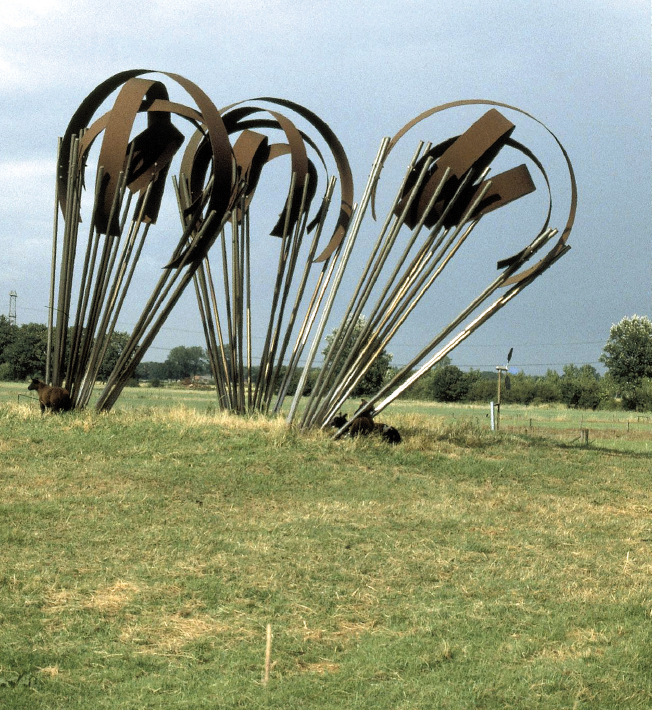
325th Glider, 504th PIR and Polish ‘Para’ Memorial, Overassett
In 1996 the entrance park with flagpoles and an orientation table were added.
Continue through Overasselt.
During the drive to Heumen the banks of the Maas are to the right. The flat ground to the right of the road from Nederasselt to Heumen is where two battalions of Colonel Tucker’s 504th PIR landed. They moved east and north to take bridges over the Maas-Waal Canal and also west to the Grave Bridge [Sketch Map 3].
• Extra Visit to Jac Maris House (Map 6/13). Round trip: 3.2 kms/2 miles. Approximate time: 5 minutes
Take the first left up Looisstraat, continue under the motorway to the distinctive white house on the left.
Jac Maris, ‘Artist and Resistance Fighter’
Born in Magdeburg in 1900, Jac Maris emigrated with his family to South Africa, returned to Kleve where he was apprenticed to a sculptor and took basic military training with a sports club. Then with memories of soldiers marching off to the First World War he moved with his family to Nijmegen. In 1927 he settled in Heumen, having travelled across Europe, including England, and remained there until his death in 1996.
In the Thirties he served in the air-raid protection service and defied evacuation on the out-break of war to stay in Heumen where he led the resistance group ‘Wendel’ which stole weapons and identification documents to help those in hiding. He maintained his sculpting work and when his house was raided by the Germans he hid in the base of the statue that he was creating to commemorate the Dutch soldiers killed in May 1940. Just before Liberation he refused to send his men to blow up bridges as he felt the tasks were too dangerous for them, a decision for which he has been criticised.
On Liberation he worked with the Americans and once the Germans had gone he worked for the Ministry of Defence and began his sculpting work again, being commissioned to make many of the memorials in the Nijmegen area visited on the itineraries in this guidebook.
The house, which Maris designed and built, is being established as a museum.
Return to the main Itinerary.
Follow signs under the A73/E31 to Heumen.
Continue into the village on Dorpstraat to the two churches opposite each other. Stop on the right.
• Jac Maris Plaque/97.8 kms/61.1 miles/5 minutes/Map 6/14
On the wall to the left of the entrance of the old Ned Church is a fine bas relief sculpture by Jac Maris. Commissioned by the 1st Battalion, the Dutch 26th Infantry Regiment, it was erected on 1 August 1939 when they were billeted in Heumen as a unit of the Border Defence. It commemorates the Battle of Mooker Heath of 1574 and shows the two commanders killed in the battle, Lodewijk and Hendrik of Nassau.
Continue over the crossroads along Boomgard and straight on along Kapt.
Postmalaan towards the banks of the Maas-Waal Canal and park by memorial on the left.
• Memorial to Dutch Soldiers and Site of Old Heuman Lockbridge/98.7 kmsl 61.7 miles/10 minutes/Map 6-15/16
As one approaches the lock the memorial to Dutch soldiers is to the left. Designed by Jac Maris and erected in 1947, it commemorates an action of 10 May 1940 when the lockbridge was lowered by sentries of the badly-equipped Dutch border defence for German assault commandos disguised as Dutch Military Policemen and civilians. When they were recognized, a battle ensued for the bridge that continued well into the afternoon of 10 May, during which twenty-four Dutch soldiers were killed. The German objective, however, to capture the bridge quickly and intact, failed. The memorial lists the names of the soldiers of 1-26 R.I. who ‘died for their fatherland on 10 May 1940’. Its traditional form of a Pieta recognizes the sacrifices of mothers in the war.
The picturesque old lockbridge was demolished in 1991. In September 1944 it had turned out to be vital. The Guards were unable to use the main road from Grave to Nijmegen and their alternative route came through Heumen. The German defenders were well entrenched on the small island to the right of the bridge, but, under cover of darkness, a company of 504th PIR commanded by Captain Thomas B. Helgeson over-ran them and took the bridge intact around 1900 hours on 17 September. Shortly afterwards, patrols of 505th PIR arrived from Groesbeek.
Return through Heumen and turn right signed to Malden under the A73/E31 on Luden Laan. Turn right again on the N271, direction Nijmegen. Continue over the Maas Canal and at the traffic lights turn left signed Malden on the N844.
Malden (103.5 kms/64.8 miles). Even two years after the end of the war 13% of Dutch households and 1.5% of the entire population still lived in temporary accommodation. In 1947 the municipality of Heumen (which includes Malden) incorporated commemorative plaques on houses that were being reconstructed as a symbol of the Netherlands rising once more from the ashes of war.
After the Grenadier Guards reached Nijmegen on 19 September and entered into the contest to take the road bridge, the Irish Group rested here. On the morning of 20 September, in preparation to support the American assault crossing of the river, the Irish moved closer to Nijmegen with one squadron of tanks positioned just to the east of the power station (qv) and another near the factory, having reached their positions with little opposition.
N.B. In Malden churchyard is a Headstone by Jac Maris for W. Thuis. Thuis was a member of Maris’s resistance group. He died from injuries received when he was escorting a transportation of German POWs to Belgium. He was buried in the cemetery at Bourg Leopold but on 17 April 1946 his remains were returned to his native town and reburied here with his parents.
Continue through Malden following signs to Nijmegen, to the traffic lights just past a green CWGC sign and turn left signed to Arnhem on Weg door Jonkerbos. Continue to the cemetery, with a carillon tower without any bells at the entrance, on the right. (There is a larger municipal plot on the left.)
• Dutch Wargraves Cemetery, Jonkerbos and Jan van Hoof Grave/109 kms/68.2 miles/10 minutes/Map 6-11/10
In the back right-hand corner is a cemetery of honour, laid out in 1971, beside which flies the Dutch flag, with a plaque to ‘The Fallen 1940-1945’. There are forty-eight headstones for victims of the War. The last stone on the right of the back row is that of Resistance Worker Jan van Hoof (qv). Beside him lies C. van Sambeek, the Company Commander of the Dutch Shock Troops.
Continue 1.1 kms/.7 mile along Weg door Jonkerbos, past the hospital to the right, to the first right turn with a green CWGC sign, signed to de Goffert. Turn here on Oude Mollenhutseweg and continue to the CWGC Cemetery parking area on the right.
• Jonkerbos CWGC Cemetery and Marienbosch Memorial/110.5 kms/69 miles/20 minutes/Map 6-7/8
The cemetery is in a wooded area known as Jonkers Bosch from which it took its name and was created by No. 3 CCS. It contains 1,639 burials, including eighteen soldiers buried in adjoining graves who could not be identified individually. They lie under Special Memorials with the legend ‘Buried near this spot’. Two other soldiers under Special Memorials are known to be buried in the cemetery but their graves were subsequently lost. There are 5 RN with 1 Unknown; 970 UK Army with 72 Unknown; 3 Canadian; 5 Belgian; 1 Dutch (and there is a Netherlands War Graves plaque at the cemetery entrance); 2 Polish; 410 RAF with 14 Unknown; 1 RCAF; 34 RAAF; 21 RNAF; 4 Polish Air Force, 1 Soviet Union; 2 entirely unidentified and 9 ‘Miscellaneous’ Unknown from the UK.
A lawn edged with silver birch leads to the elegant colonnaded shelter where the Register and Visitor’s Book are housed. Through its arches the Cross of Sacrifice can be seen at the end of the central avenue. Beyond the shelter, to the left, is a stone column which commemorates the men who were removed to this cemetery from one near the Marienbosch Convent in Sophiaweg. It bears a quotation from Rupert Brooke’s The Soldier, ‘There is a corner in [sic] a foreign field That is for ever England’ and the inscription, ‘To those men of the British and Allied Forces who gave their lives and are buried here. Marienbosch Sept-Oct 1944. Jonkerbosch.’ The Marienbosch burial ground was a typical hospital graveyard, with the graves made by medical staff as the men died of their wounds. The graveyard was enclosed by a white wooden fence, the graves marked by white wooden crosses, but with a darker cross for a lone Dutch civilian, Albert van Dam. The left-hand side of the cemetery was for Operation GARDEN period burials for September/October 1944, the right side for Operation VERITABLE from 8 February 1945. Photos exist of this major cemetery, showing pilgrims visiting the graves (see Vanished Temp Cemeteries (qv) by Father Thuring and J. Hey, which also lists the 250 men originally buried there but who are now in Jonkerbos).

Site of old lockbridge, Heumen
The Special Memorials are to the right. The plots are arranged in a pleasing fan shape facing the central Stone of Remembrance, standing as if on parade. Landscaped beds of shrubs, horse chestnut and shaped yew trees add to the beauty of this lovely cemetery
The MC was awarded to Lieutenant Lindsay Baker, 2/5th Gloucesters, age 21, 3 April 1945 [6.G.8.]; Major Kenneth Lowe, 7th Black Watch, age 26, 23 September 1945 [14.C.1.]; Lieutenant Adrian Slob, 1st Grenadier Guards, 23 February 1945, from Friesland [18.A.4.] and Major Sydney Young, 7th SLI, age 30, 23 September 1944 [I1.F.2.].
The MM was awarded to Lance Serjeant William Pearson, RE, age 26, 26 November 1944 [Sp Mem ‘A. No 2.] and Lieutenant Owen Shanks, 7th Black Watch, age 35,8 February 1945 [14.G.3.].
The DFC was awarded to WO (Pilot) Mark Azouz, RAF, age 22, 21 September 1944 [17.G.2.]; Captain Cecil Ballyn, RA, attd RAF, age 38,18 March 1945, who also had a Bar to his DFC [13.E.4.] as did Flight Lieutenant Leslie Barr, RAF, age 28,11 September 1942 [12.D.8]; Flight Lieutenant Walter Bell, RAF, age 25, 21 July 1944 [24.1.6.]; Flying Officer Neville Briant, RAF, age 24, 5 October 1942 [8.F.4.]; Squadron Leader Gilbert Campbell, RAF, 19 November 1944 [20.A.7.]; Flying Officer (Naval) Douglas Farquhar, RAAF, age 23,19 November 1944, whose parents lived in New York State, USA [20.A.8-9.]; Squadron Leader William Fletcher, RAF, age 29, 14 February 1943, also had the DFM [12.E.2-5]; Flight Lieutenant (Naval) Norman Fredman, RAF, age 23, 6 May 1944 [24.E.9.]; Squadron Leader William Greenslade, AFC, RAF, 2 October 1942 [20.D.3.]; Flying Officer Norman Marston, RAF, age 24, 25 May 1944 [24.J.2-4.]; Flight Lieutenant Norman Pye, RAF, 8 April 1945 [17.C.1.]; Flight Lieutenant Thomas Rawlinson, RAF, 25 May 1944 [24.J.6.]; Squadron Leader Harry Stephens, RAF, age 32, 6 May 1944 [24.E.8.] had a brother, Wing Commander John Stephens, age 25, who also won the DFC. He died on 30 August 1943 and is buried in Friern Barnet Churchyard, Middx; Squadron Leader Philip Turgel, RAF, age 22, 26 May 1943 [24.C.8-9.]; Flight Lieutenant Eric Willcox, 1 September 1941 [12.G.9.].
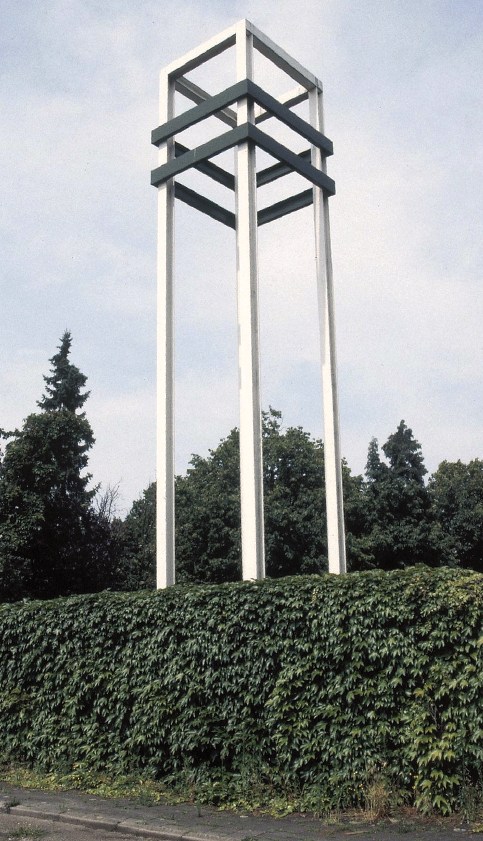
Tower at entrance to Dutch War Graves Cemetery, Jonkerbos and Jan van Hoof Headstone with incorrect date of death
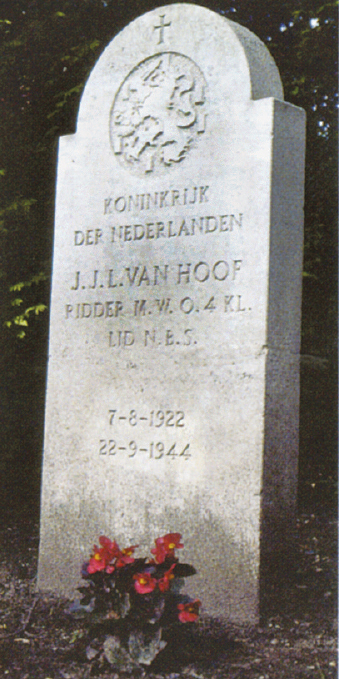
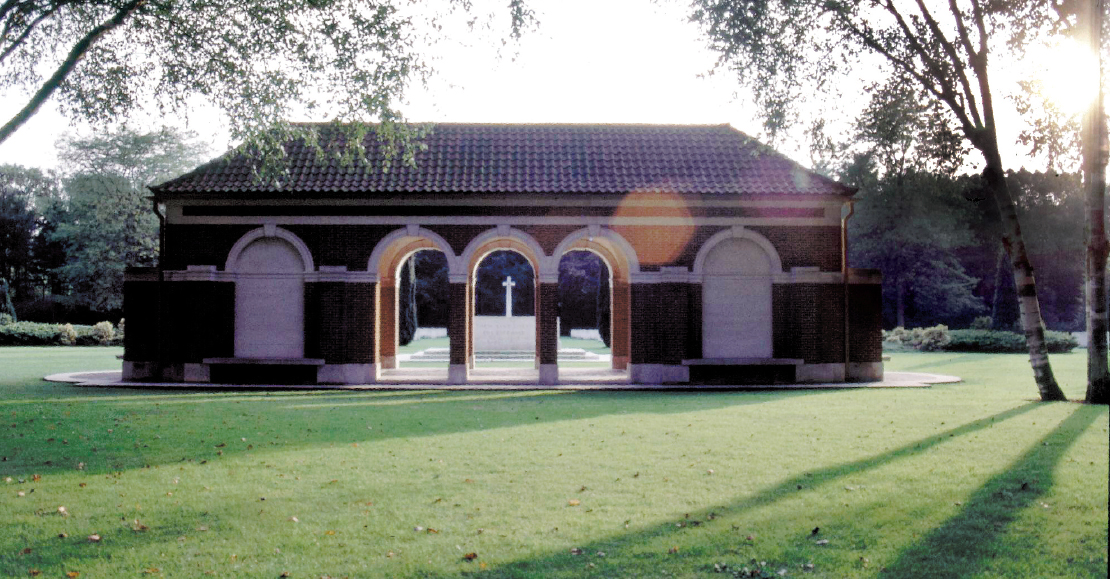
Jonkerbos CWGC Cemetery: General view, Memorial to Marienbosch Temp. Cemetery, Personal Tribute

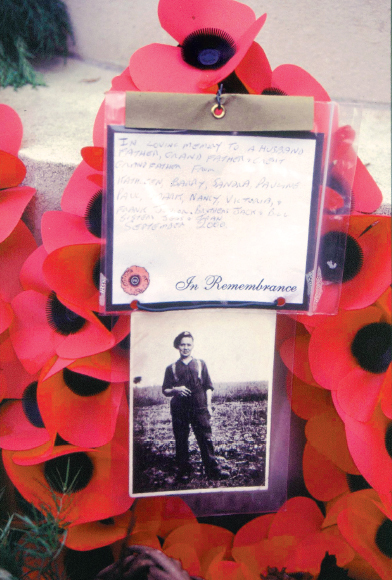
The DFM was awarded to Flight Sergeant Frederick Barker, RAF, age 23, 31 May 1942 [12.H.8.]; Sergeant Douglas Bebensee, RCAF, 14 July 1943 [16.E.5.]; WO (Pilot) Kenneth Breckon, RAF, age 21, 23 August 1943 [16.B.1-3.]; Flight Sergeant Francis Hay, RAF, 30 May 1943 [24.B.8.]; Sergeant Harry Kay, RAF, age 28, 14 February 1943 [Coll grave 12.E.2-5.J; Sergeant Kenneth McKay, RAF, age 22, 5 October 1942 [8.F.7.]; Pilot Officer George Miller, RAF, 14 February 1943 [Coll grave 12.E.2-5.]; Sergeant Donald Sills, RAF, age 22,1 July 1941 [12.G.3-4.]
The DCM was awarded to Trooper Frank Craddock, 1st Fife & Forfar Yeomanry, age 27, 8 February 1945 [3.E.4.].
MiD were Corporal George Binks, 4th Wilts, age 33,10 October 1944 [9.G.I.]; Corporal George Birch, 1st Leics, age 25, 6 March 1945 [21.B.8.]; Major William Broome, 1st Worcesters, age 30, 30 September 1944 [21.E.1.]; Sub-Lieutenant John Burke, RNVR, age 22, 15 May 1945 [24.J.9.]; Lieutenant Norman Clark, RE, age 25, 6 April 1945 [14.F.5.]; Flying Officer Robert Davidson, RAF, age 28, 6 April 1945 [17.C.2.]; Serjeant Michael Dunne, 3rd Irish Guards, age 33,15 February 1945 was three times mentioned [22.F.7.]; Flight Lieutenant William Ewart, RAAF, age 25, 2 June 1945 [20.E.3.]; Flying Officer Ronald Gibbs, RAF, age 22, 3 February 1945 [8.E.2.]; Sergeant Ernest Grunsell, RAF, aged 20,27 March 1941 [16.C.9.]; Sub-Lieutenant Peter Hoad, RN of HMS Daedalus, age 22, 27 March 1941 [20.F.9.]; Major Anthony Hunter, 6th Royal Scots, MC, Medal for Distinguished Service in Battle (USSR), age 32, 20 February 1945 [9.C.2.]; Sapper Percy Plackett, RE, age 34, 15 November 1944 [6..G.4.]; Bombardier George Walsh, RA, age 42, 26 September 1944 [15.A.5.].
Lieutenant Roger Denys Green, 12th Queen’s Westminsters, age 21, 2 April 1945, was awarded the Croix de Guerre with Silver Star [14.E.2.] Major Arthur Elveden, Viscount, 55th Anti-Tank Regt, age 32,8 February 1945, was the son of Captain Rupert Guinness, CB, CMG, DL, RNVR, 2nd Earl of Iveagh and the Countess of Iveagh, CBE [21.B.7.]. The brothers of the following also died on service: Private Leslie Frost, 1/4th KOYLI, age 25, 29 December 1944 [15.G.4.], Private Thomas Frost RASC, age 32, 17 February 1942, buried in Wetherby Cemetery; Pilot Officer George Gascoyne, DFM, RAF, age 27, 2 June 1942 [20.E.4.], Flight Sergeant John Gascoyne, RAFVR, age 23, 21 February 1945, buried in Reichswald Forest CWGC Cemetery (qv); Lieutenant Douglas Hutton, 2nd Argyll & Sutherland Highlanders, age 20,9 February 1945 [6.E.4.], Private Ronald Hutton, 14th Army Field Wksp, age 19,23 May 1940, buried in Audruicq Churchyard & Extension, Pas de Calais;. Private Glyn Samuel, 1st Dorsets, age 19, 3 October 1944 [4.D.2.], Craftsman Towyn Samuel of 6 Tank Bde Wksp, REME, killed on 24 June 1944 by a flying bomb and buried in Lenham Churchyard, Kent. The sister of Flying Officer John Wallace, (Nav) RAF, age 21, 13 May 1943 [24.D.4], Agnes H. Wallace, Nurse, age 25, died on the SS City of Benares (Merchant Navy) on 17 September 1940. She is commemorated on the Tower Hill Merchant Navy Memorial, London.
Guardsman Albert Shaw, 2nd Bn, Grenadier Guards, age 23 [22.A.2.] and Lance Serjeant William Berry, age 30 [I.D.2.] were killed in their Humber Scout Car with the Dutch Resistance worker Jan van Hoof (qv) on 19 September. Their headstones record the date of death as 21 September.
A group of 18 members of S Coy, 156 Battalion, 4 Para Brigade were killed on 18 September 1944 when their C-47 Dakota 43-15180 was shot down near Ochten en route to Arnhem. They were half of a machine-gun platoon. The other half were in another plane. Privates George Brownlow, Arthur Butler, Harold Clayton, John Clayton, Richard Fuller, George Daniel, George Gilliver, Harry Hopwood, Eric Jones, Richard Killingworth, Henry Philpotts, Harold Stanyer, Thomas Stevens, Patrick Taylor, George Tutton and Joseph Wilson, Corporal Owen Lilly and Sergeant John Kinsleysmith are buried in Special Memorials 8.A.1-9 and 8.B.1-9. They were originally buried near their aircraft where today there is a memorial (qv).
Captain the Hon Vicary Gibbs (qv), 1st Grenadier Guards, age 23,20 September 1944, was the son of the 4th Baron Aldenham [22.G.4.]. He was originally buried in the Nebo Seminary grounds (qv), as was Guardsman Andrew Wardrope, age 24,11 February 1945 [22.B.4].
Return to Weg door Jonkerbos and turn right, signed Centrum and Arnhem. Pass the Philips complex on the left, go under the railway bridge and turn right on the N326 towards the centre of Nijmegen on Graafsweg.
On the right is the old Dutch civilian cemetery (112 kms/70 miles) where German casualties of the Nijmegen battle were buried. After the war they were removed to Ysselsteyn.
Drive over the railway bridge and continue to Keizer Karel Plein.
As you drive around the large roundabout area the first exit to the right that you pass is Groesbeekseweg (the road to Groesbeek). It was at that point that A Company of Colonel Warren’s 1st Battalion 508th PIR, making the first American attempt to take the Nijmegen road bridge (about 1km ahead), met German resistance. It was about 2200 hours on 17 September and as the Americans got ready to attack they heard the sound of lorries and men dismounting. When the 508th assault began the SS counter-attack forced the Americans on the defensive and shortly after General Gavin ordered them to withdraw and to reorganise. Nevertheless, Captain Jonathan E. Adams Jr, the company commander, had already led a patrol forward towards the Post Office (qv).
In the centre of the square is an equestrian statue of Charlemagne. Ahead is the handsome Concert and Exhibition Hall, built in 1915 by Oscar Leeuw, with its massive brick facade and classical ornamentation. After Nijmegen’s Liberation in September 1944, it was a leave centre for Allied troops and was known as The Winter Gardens. To the left is the RABO Bank building, in the ground floor of which is the
• Nijmegen VVV/114 kms/71.4 miles
2 Keizer Karel Plein, NL-6511 NC Nijmegen. Tel: 0900 1122344. www.vvvnijmegen.nl. E-mail: info@vvvnijmegem.nl
On two floors and with helpful, English-speaking staff, the VVV sells tourist maps, souvenirs and has details of local hotels, restaurants, tourist attractions and an attractive range of souvenirs. It is on the site of the former Stork Club, a Canadian Officers’ Club.
To the left along Van Schaeck Mathon Singel is Nijmegen’s main railway station with a currency exchange booth.
• Extra Visits to Memorial to Resistance Workers, Public Garden, Herman Oolbekkinkstraat (Map 6/25), British graves in Nijmegen (Rustoord) Cemetery (Map 6/24) and Plaque to Jewish Casualties, Jewish Cemetery (Map 6/23). Round trip: 6.4 kms/4 miles. Approximate time: 20 minutes
Take the Groesbeek turning off Keizer Karel Plein and after 100m fork left to Groesbeek. Continue to the junction with Postweg at the third traffic lights. Turn left and then immediately right on to Herman Oolbekkinkstraat. Continue through the archway at the end of the road and the memorial is immediately to the right (2.1 kms/1.3 miles).
The Memorial, in the form of a pelican, symbol of compassion, commemorates four policemen (three detectives and a photographer), members of the Nijmegen Resistance, who were arrested after the failed assassination attempt on the SD traitor Ederveen. After a trial at Velp they were executed by firing squad in the dune near Overveen on 6 June 1944. The statue, by Ben van Pinxtern, was erected on 12 September 1987.
Return to Postweg and turn right. Continue to
The Rustoord Protestant Cemetery on the right (2.7 kms/1.7 miles). Beside the entrance to this large cemetery is a CWGC sign. The grave of Private William Currie, 5th E. Yorks, age 25, 23 September 1944, is in the north-west corner of the cemetery. There are also four 1914-1918 war graves in the south-eastern corner near the entrance.
Continue to the corner of Kwakkenberg and the Jewish Cemetery. Drive right past and round it and back onto Postweg. You then stop on the right side of the road.
Plaque to Nijmegen’s Jewish Casualties (3.2 kms/2 miles). The cemetery is only open for relatives of the wartime casualties. At the beginning of 1941 there were 527 members of the Jewish Community. Large-scale deportations took place in the autumn of 1942 and by September 1944 it is thought that 501 Jews were deported to Auschwitz and Sobibor, of whom none returned. The plaque, which is to the right on the wall just inside the iron gates (which may well be locked) commemorates those who were not allowed to find their last resting place here.
Return to Keizer Karel Plein and pick up the main Itinerary.
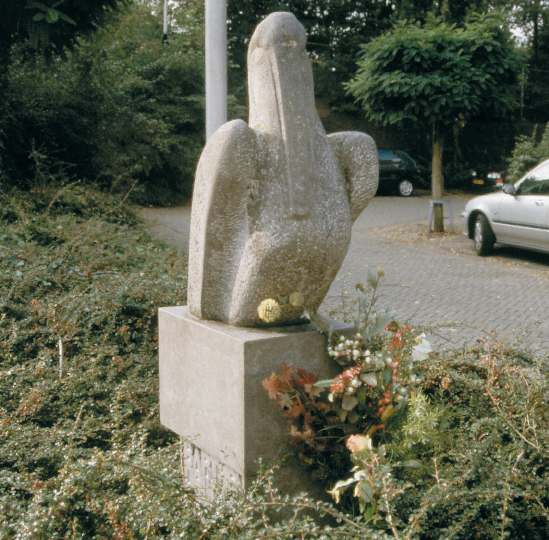
Memorial to Resistance Workers, Herman Oolbekkinkstraat
Take Oranje Singel off Keizer Karel Plein signed to Arnhem and continue as the road becomes Sint Canisiussingel towards the Waal.
At the first traffic lights, with the yellow brick building of the Magistrates’ Court on the corner to the left, can be seen the tall TV and radio tower that marks the position of the brown brick Post Office (Map IN/7). The 508th PIR commanded by Colonel Lindquist had a complex role which divided between taking and holding the high ground around Groesbeek and sending a company to take the Nijmegen road bridge. There was confusion concerning Lindquist’s exact priorities which we discuss later, but he did send a platoon-size patrol into Nijmegen at around 1830 hours to investigate Dutch intelligence information that only eighteen Germans guarded the southern end of the bridge and, if possible, to capture it. That patrol got lost until the following morning. Gavin, learning that no move had apparently been made on the bridge, told Lindquist ‘to delay not a second longer and get to the bridge as quickly as possible’. Although Colonel Shields Warren, commanding the 1st Battalion of the 508th, was ordered to move on the bridge at 1800 hours it was four hours before he could get going with A Company. A supposed member of the Dutch Underground volunteered to lead them to the bridge but en route he disappeared. Warren waited for some time to see if the Dutchman would return. He didn’t, so Warren continued and met the Germans at Keizer Karel Plein as described earlier. Warren believed that the bridge could be blown by using control apparatus in the Post Office and at 2200 hours sent Captain Adams, the A Company commander, there with a patrol. The Americans destroyed some equipment, but because of enemy reaction were unable to get out of a shop on the corner of Hezelstraat-Jodenberg until relieved three days later. The Germans, however, would hold the bridge for another three days despite another unsuccessful attempt by the 508th under Gavin’s urging to take the bridge on the following morning, the 18th (G Company of Lieutenant-Colonel Louis G. Mendez’s 3rd Battalion 508th PIR) and yet another on the afternoon of the 19th by a combined American and Grenadier force (see Itinerary Four, the Valkhof entry).
Continue to the large roundabout, Keizer Traianus Plein (115.5 kms/72.1 miles).
• End of Itinerary Two
